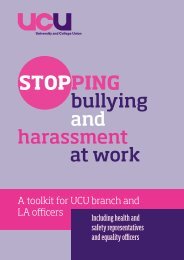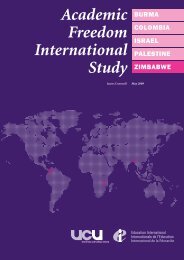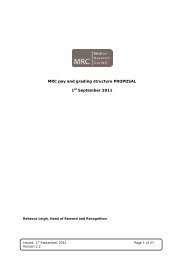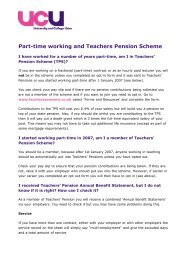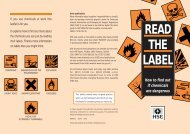a survey of stress and well-being among staff in higher ... - UCU
a survey of stress and well-being among staff in higher ... - UCU
a survey of stress and well-being among staff in higher ... - UCU
You also want an ePaper? Increase the reach of your titles
YUMPU automatically turns print PDFs into web optimized ePapers that Google loves.
Higher<strong>stress</strong>A SURVEY OF STRESS ANDWELL-BEING AMONG STAFFIN HIGHER EDUCATIONGAIL KINMAN <strong>and</strong>SIOBHAN WRAYJULY 2013
ContentsSummary 3Introduction 5F<strong>in</strong>d<strong>in</strong>gs1 Biographical <strong>in</strong>formation 112 Responses to HSE <strong>stress</strong> questionnaire 12Dem<strong>and</strong>s 12Control 15Manager's support 18Peer support 20Relationships 22Role 24Change 263 Overall perceptions <strong>of</strong> <strong>stress</strong> 284 Work-life balance <strong>and</strong> <strong>stress</strong> 305 Sickness absence 326 Differences between groups 337 Conclusion 34Endnote: Tackl<strong>in</strong>g occupational <strong>stress</strong> 36References 37Appendix: The questionnaire 39Dr Gail K<strong>in</strong>man is Pr<strong>of</strong>essor <strong>of</strong> Occupational Health Psychology at theUniversity <strong>of</strong> Bedfordshire.Siobhan Wray is a PhD Researcher at the University <strong>of</strong> Bedfordshire.University <strong>and</strong> College Union (<strong>UCU</strong>)is the largest trade union <strong>and</strong> pr<strong>of</strong>essional association for academics, lecturers,tra<strong>in</strong>ers, researchers <strong>and</strong> academic-related <strong>staff</strong> work<strong>in</strong>g <strong>in</strong> further <strong>and</strong> <strong>higher</strong>education throughout the UK.www.ucu.org.uk
Summaryn Nearly three-quarters <strong>of</strong> the sample agreed or strongly agreed with thestatement ‘I f<strong>in</strong>d my job <strong>stress</strong>ful’. More than half <strong>in</strong>dicated that theirgeneral level <strong>of</strong> <strong>stress</strong> was high or very high, <strong>and</strong> more than one third saidthey <strong>of</strong>ten or always experienced levels <strong>of</strong> <strong>stress</strong> they found unacceptable.Only 2% <strong>of</strong> the sample reported that they never experienced unacceptablelevels <strong>of</strong> <strong>stress</strong> at work.n F<strong>in</strong>d<strong>in</strong>gs <strong>in</strong>dicate that levels <strong>of</strong> perceived <strong>stress</strong> rema<strong>in</strong> high <strong>in</strong> the <strong>higher</strong>education sector. In the present <strong>survey</strong>, the proportion <strong>of</strong> respondents from<strong>higher</strong> education who agreed or strongly agreed with the statement ‘I f<strong>in</strong>dmy job <strong>stress</strong>ful’ was one percentage po<strong>in</strong>t lower than that found <strong>in</strong> anational <strong>survey</strong> <strong>of</strong> the sector conducted <strong>in</strong> 2008.n Work<strong>in</strong>g hours rema<strong>in</strong> high <strong>in</strong> <strong>higher</strong> education. More than three-quarters <strong>of</strong>respondents employed on a full-time contract worked over 40 hours a week,<strong>and</strong> more than one third <strong>in</strong> excess <strong>of</strong> 50 hours a week. More than onequarter <strong>of</strong> the respondents from <strong>higher</strong> education exceeded the 48 hourmaximum number <strong>of</strong> work<strong>in</strong>g hours stipulated by the EU Work<strong>in</strong>g TimeDirective (HMSO, 1998).n On all but one <strong>of</strong> the Health <strong>and</strong> Safety Executive <strong>stress</strong>or categories, <strong>UCU</strong>members <strong>in</strong> <strong>higher</strong> education reported lower <strong>well</strong>-<strong>be<strong>in</strong>g</strong> than the average forthose work<strong>in</strong>g <strong>in</strong> the target group <strong>in</strong>dustries (<strong>in</strong>clud<strong>in</strong>g education). Thebiggest ‘<strong>well</strong>-<strong>be<strong>in</strong>g</strong> gaps’ related to work dem<strong>and</strong>s, change management,management support <strong>and</strong> role clarity. This is a similar pattern to that whichemerged <strong>in</strong> <strong>UCU</strong>’s 2008 study, but the <strong>well</strong>-<strong>be<strong>in</strong>g</strong> gaps <strong>in</strong> relation to all<strong>stress</strong>ors apart from control have widened, highlight<strong>in</strong>g particular problems<strong>in</strong> these areas.n As <strong>in</strong> the 2008 <strong>survey</strong>, levels <strong>of</strong> control <strong>in</strong> the <strong>higher</strong> education sectorexceeded the benchmark from the HSE’s target group <strong>in</strong>dustries (<strong>in</strong>clud<strong>in</strong>geducation), <strong>and</strong> the HSE’s <strong>in</strong>terim target benchmark. Nonetheless, overallperceptions <strong>of</strong> <strong>well</strong>-<strong>be<strong>in</strong>g</strong> related to work-related control have reduced s<strong>in</strong>ce2008.n <strong>UCU</strong> members <strong>in</strong> <strong>higher</strong> education who had a bigger <strong>well</strong>-<strong>be<strong>in</strong>g</strong> gap on theHSE <strong>stress</strong>or categories tended to perceive more work-related <strong>stress</strong> <strong>and</strong>have a poorer work-life balance.n Respondents with poorer <strong>well</strong>-<strong>be<strong>in</strong>g</strong> on the HSE <strong>stress</strong>or categories <strong>in</strong>relation to relationships, control <strong>and</strong> dem<strong>and</strong>, <strong>and</strong> who reported <strong>higher</strong>levels <strong>of</strong> perceived <strong>stress</strong>, had taken more days <strong>of</strong>f sick <strong>in</strong> the previous 12month period.n The work-life balance <strong>of</strong> <strong>UCU</strong> members from <strong>higher</strong> education is generallypoor. The majority <strong>of</strong> respondents from HE appeared unable to set anacceptable boundary between their work <strong>and</strong> home life. More than half<strong>in</strong>dicated that they <strong>of</strong>ten neglected their personal needs because <strong>of</strong> thedem<strong>and</strong>s <strong>of</strong> their work. Those who had a poorer work-life balance <strong>and</strong>weaker boundaries between work <strong>and</strong> home tended to report <strong>higher</strong> levels<strong>of</strong> work-related <strong>stress</strong>.3
n On the whole, <strong>UCU</strong> members employed <strong>in</strong> teach<strong>in</strong>g-<strong>and</strong>-research rolesreported lower levels <strong>of</strong> <strong>well</strong>-<strong>be<strong>in</strong>g</strong> relat<strong>in</strong>g to dem<strong>and</strong>s, control <strong>and</strong> peersupport <strong>and</strong> <strong>higher</strong> levels <strong>of</strong> work-life conflict <strong>and</strong> <strong>stress</strong> than thoseemployed <strong>in</strong> teach<strong>in</strong>g or research jobs.n <strong>UCU</strong> members employed <strong>in</strong> academic roles reported poorer <strong>well</strong>-<strong>be<strong>in</strong>g</strong> <strong>in</strong>relation to all <strong>of</strong> the HSE <strong>stress</strong>or categories than academic-related <strong>staff</strong>,together with <strong>higher</strong> levels <strong>of</strong> <strong>stress</strong> <strong>and</strong> work-life conflict.4
IntroductionWork-related <strong>stress</strong> is def<strong>in</strong>ed as ‘The adverse reaction people have toexcessive pressures or other types <strong>of</strong> dem<strong>and</strong> placed on them at work’ (HSE,nd1). It is one <strong>of</strong> the most commonly reported health problems experienced byemployees. Accord<strong>in</strong>g to data from the Labour Force Survey, work-related<strong>stress</strong>, depression or anxiety caused or made worse by the employee’s currentor most recent job, for people work<strong>in</strong>g <strong>in</strong> the preced<strong>in</strong>g 12 months, affected anestimated 369,000 employees <strong>in</strong> 2011/12 <strong>in</strong> the UK, with a total <strong>of</strong> 9,072,000work<strong>in</strong>g days lost (HSE, nd2). With<strong>in</strong> that total, teach<strong>in</strong>g <strong>and</strong> educationalpr<strong>of</strong>essionals reported the highest average number <strong>of</strong> days lost per worker dueto work-related <strong>stress</strong> depression <strong>and</strong> anxiety.As <strong>well</strong> as ill health <strong>and</strong> sickness absence, work-related <strong>stress</strong> has also beenassociated with reduced levels <strong>of</strong> job satisfaction, motivation <strong>and</strong> commitment,<strong>in</strong>creased employee turnover, impaired job performance <strong>and</strong> creativity, <strong>and</strong> arange <strong>of</strong> counterproductive workplace attitudes <strong>and</strong> behaviours such ascynicism, <strong>in</strong>civility <strong>and</strong> sabotage (K<strong>in</strong>man & Jones, 2001; Spector et al., 2005).The negative impact <strong>of</strong> work-related <strong>stress</strong> is also likely to ‘spill over’ <strong>in</strong>to thehome doma<strong>in</strong> <strong>and</strong> limit opportunities for relaxation <strong>and</strong> recovery, lead<strong>in</strong>g toimpaired health <strong>and</strong> job performance (Allen et al., 2000).The <strong>in</strong>cidence <strong>of</strong> workplace <strong>stress</strong> has generally risen s<strong>in</strong>ce the mid-1990s,especially <strong>among</strong> public sector workers. There is evidence, however, thatpeople work<strong>in</strong>g <strong>in</strong> education are at greater risk <strong>of</strong> work <strong>stress</strong> <strong>and</strong> <strong>stress</strong>-relatedabsence than most other occupational groups (as noted above). Unsurpris<strong>in</strong>gly,education has been identified as a priority area for the reduction <strong>of</strong> workrelated<strong>stress</strong> (Tyers et al., 2009). Several studies conducted <strong>in</strong> recent years<strong>in</strong>dicate that work-related <strong>stress</strong> is widespread <strong>in</strong> post compulsory education <strong>in</strong>the UK (Villeneuve-Smith, Munoz & McKenzie, 2008; Court & K<strong>in</strong>man, 2009a,2009b, 2009c).Moreover, recently published European research <strong>in</strong>dicates that British academicemployees are, by a large marg<strong>in</strong>, the least satisfied <strong>in</strong> Europe <strong>and</strong> themost likely to regret their choice <strong>of</strong> career (Hohle & Teichler, <strong>in</strong> press). Severalstudies conducted <strong>in</strong> the <strong>higher</strong> education sector have associated work-related<strong>stress</strong> with low levels <strong>of</strong> job satisfaction (e.g. K<strong>in</strong>man, 1998; McClenahan, Giles& Mallet, 2007; Byrne et al., 2012). Reflect<strong>in</strong>g these f<strong>in</strong>d<strong>in</strong>gs, the Europeanstudy also reported that 61% <strong>of</strong> senior academics <strong>and</strong> 56% <strong>of</strong> junior academicsfrom the UK described their job as ‘a considerable source <strong>of</strong> stra<strong>in</strong>’.Several factors are likely to have contributed towards the poor work-related <strong>well</strong><strong>be<strong>in</strong>g</strong><strong>of</strong> <strong>UCU</strong> members. Post-compulsory education <strong>in</strong> the UK has undergone aperiod <strong>of</strong> considerable change that has challenged the resources <strong>of</strong>organisations <strong>and</strong> employees. The nature <strong>of</strong> academic <strong>and</strong> academic-relatedroles has changed considerably <strong>and</strong> dem<strong>and</strong>s have <strong>in</strong>creased substantially.Student numbers have <strong>in</strong>creased more than 2.5-fold over the last 20 years, <strong>and</strong>a more diverse student population hold<strong>in</strong>g an <strong>in</strong>creas<strong>in</strong>gly ‘consumer oriented’approach to their studies has been documented (CHERI, 2007; 2011). The<strong>in</strong>troduction <strong>of</strong> student fees has led to a reassessment <strong>of</strong> ‘value for money’,<strong>and</strong> competition between universities <strong>and</strong> colleges for home <strong>and</strong> <strong>in</strong>ternationalstudents has <strong>in</strong>creased. The <strong>in</strong>troduction <strong>of</strong> national <strong>and</strong> global rank<strong>in</strong>gs <strong>of</strong>5
excellence <strong>in</strong> a number <strong>of</strong> areas has compounded the <strong>stress</strong> experienced by<strong>staff</strong> (Hazelkorn, 2011). Market-led policies <strong>and</strong> globalisation necessitateregular curriculum redesign <strong>and</strong> diverse modes <strong>of</strong> delivery, which requireenhanced pr<strong>of</strong>essional <strong>and</strong> technical skills from academic <strong>and</strong> support <strong>staff</strong>.Enhanced regulatory dem<strong>and</strong>s <strong>and</strong> performance management structuresrelat<strong>in</strong>g to teach<strong>in</strong>g <strong>and</strong> research have been <strong>in</strong>troduced. Staff employed <strong>in</strong>universities <strong>and</strong> colleges have experienced <strong>in</strong>creased dem<strong>and</strong>s for excellence<strong>in</strong> teach<strong>in</strong>g, adm<strong>in</strong>istration <strong>and</strong> pastoral care, as <strong>well</strong> as more pressure to boostfund<strong>in</strong>g through entrepreneurial activities (CHERI, 2007). Universities are als<strong>of</strong>orced to compete more fiercely for research grants <strong>and</strong> the forthcom<strong>in</strong>gResearch Excellence Framework requires academic employees to not onlyproduce excellent research, but evidence its broad impact.Fixed-term or other forms <strong>of</strong> casual contracts for <strong>staff</strong> <strong>in</strong> <strong>higher</strong> education arewidespread - particularly for research-only academic <strong>staff</strong>. In <strong>higher</strong> education<strong>in</strong> the UK <strong>in</strong> 2011-12, accord<strong>in</strong>g to the Higher Education Statistics Agency’sStaff Record, analysed by University <strong>and</strong> College Union, 36% <strong>of</strong> all academics,<strong>in</strong>clud<strong>in</strong>g 60% <strong>of</strong> teach<strong>in</strong>g-only <strong>staff</strong> <strong>and</strong> 68% <strong>of</strong> research-only <strong>staff</strong>, were onfixed-term contracts - a factor likely to have impacted on perceptions <strong>of</strong> jobsecurity. The trend towards greater rationalisation <strong>of</strong> universities <strong>and</strong> collegesthrough closure <strong>and</strong> merger is likely to cont<strong>in</strong>ue (CHERI, 2011). High levels <strong>of</strong>job <strong>in</strong>security have been found <strong>in</strong> previous studies <strong>of</strong> <strong>UCU</strong> members (K<strong>in</strong>man &Jones, 2004; Court & K<strong>in</strong>man, 2009a, 2009b, 2009c). Job <strong>in</strong>security has alsobeen cited as a considerable source <strong>of</strong> <strong>stress</strong> <strong>in</strong> <strong>UCU</strong> members <strong>and</strong> othersamples <strong>of</strong> university <strong>and</strong> college employees (K<strong>in</strong>man & Jones, 2004;Tytherleigh, Webb, Cooper & Ricketts, 2005).Research conducted over the last 10 to 15 years <strong>in</strong>dicates that levels <strong>of</strong> psychologicaldi<strong>stress</strong> <strong>among</strong>st employees <strong>in</strong> post-compulsory education arecomparatively high. The f<strong>in</strong>d<strong>in</strong>gs <strong>of</strong> a systematic review conducted by Watts <strong>and</strong>Robertson (2011) highlighted levels <strong>of</strong> burnout <strong>among</strong>st university teach<strong>in</strong>g<strong>staff</strong> compara-ble with ‘at risk’ groups such as healthcare pr<strong>of</strong>essionals.Academics engaged <strong>in</strong> teach<strong>in</strong>g <strong>and</strong> research, rather than those who are justteachers or researchers, tended to report the highest levels <strong>of</strong> <strong>stress</strong> (W<strong>in</strong>efield& Jarrett, 2001). Two UK <strong>survey</strong>s <strong>of</strong> academic <strong>and</strong> academic-related <strong>staff</strong>conducted <strong>in</strong> 1998 <strong>and</strong> 2004 1 found high levels <strong>of</strong> job-related <strong>stress</strong>ors <strong>and</strong> alevel <strong>of</strong> psychological di<strong>stress</strong> that exceeded that reported by other pr<strong>of</strong>essionalgroups (K<strong>in</strong>man, 1998; K<strong>in</strong>man & Jones 2004; K<strong>in</strong>man et al., 2006). The most<strong>stress</strong>ful aspects <strong>of</strong> work <strong>in</strong>cluded rushed pace <strong>of</strong> work, <strong>in</strong>adequateadm<strong>in</strong>istrative <strong>and</strong> technical support, lack <strong>of</strong> respect <strong>and</strong> esteem, too muchadm<strong>in</strong>istrative paperwork, poor promotion opportunities, <strong>in</strong>effectivecommunication, <strong>and</strong> lack <strong>of</strong> opportunity for scholarly work. Levels <strong>of</strong> many <strong>of</strong>these <strong>stress</strong>ors rema<strong>in</strong>ed high <strong>in</strong> the sector <strong>in</strong> the six year period between1998 <strong>and</strong> 2004 (K<strong>in</strong>man et al., 2006).1 Surveys <strong>of</strong> members <strong>of</strong> the Association <strong>of</strong>University Teachers.The study conducted <strong>in</strong> 2004 revealed that a considerable proportion <strong>of</strong> members<strong>of</strong> the Association <strong>of</strong> University Teachers were work<strong>in</strong>g <strong>in</strong> excess <strong>of</strong> the 48hour weekly limit set by the European Union’s Work<strong>in</strong>g Time Directive (HMSO,1998). More specifically, 59% <strong>of</strong> respondents employed on a full-time basis6
worked more than 45 hours <strong>in</strong> a typical week <strong>and</strong> 21% <strong>in</strong> excess <strong>of</strong> 55 hours.Almost one half <strong>of</strong> the sample worked regularly dur<strong>in</strong>g even<strong>in</strong>gs <strong>and</strong> weekends<strong>in</strong> order to cope with the dem<strong>and</strong>s <strong>of</strong> their work. Academic <strong>staff</strong> <strong>in</strong>volved <strong>in</strong>both teach<strong>in</strong>g <strong>and</strong> research tended to report longer work<strong>in</strong>g hours. Unsurpris<strong>in</strong>gly,a high level <strong>of</strong> conflict between work <strong>and</strong> home life was reported, <strong>and</strong> wasthe strongest predictor <strong>of</strong> psychological di<strong>stress</strong>. Boundaries between work <strong>and</strong>home were blurred for the majority <strong>of</strong> respondents, <strong>and</strong> few reported that theywere able to achieve an acceptable work-life balance. The negative impact <strong>of</strong>work-life conflict on health <strong>and</strong> family-life has been widely demonstrated(K<strong>in</strong>man & Jones, 2001). The 2004 study reported that work dem<strong>and</strong>s tendedto spill over <strong>in</strong>to the home doma<strong>in</strong> both physically (e.g. work<strong>in</strong>g at home dur<strong>in</strong>geven<strong>in</strong>gs <strong>and</strong> weekends), <strong>and</strong> psychologically (e.g. preoccupation with workproblems, difficulties <strong>in</strong> sleep<strong>in</strong>g, <strong>and</strong> irritability with family <strong>and</strong> friends).Although few respondents wished for total separation between their work <strong>and</strong>home lives, the majority desired more separation than they currentlyexperienced.From the research discussed above, it is clear that the post-compulsoryeducation sector <strong>in</strong> the UK is cont<strong>in</strong>u<strong>in</strong>g to experience fundamental changes.This is likely to have a cont<strong>in</strong>ued negative impact on the <strong>well</strong>-<strong>be<strong>in</strong>g</strong> <strong>of</strong> <strong>UCU</strong>members, <strong>and</strong> it is likely that work-related <strong>stress</strong> is likely to cont<strong>in</strong>ue to be high.The HSE managementst<strong>and</strong>ards approachThe Health <strong>and</strong> Safety Executive (HSE: the UK body responsible for policy <strong>and</strong>operational matters related to occupational health <strong>and</strong> safety) has developed aprocess to help employers manage the work-related <strong>well</strong>-<strong>be<strong>in</strong>g</strong> <strong>of</strong> their <strong>staff</strong>. Arisk-assessment approach is advocated whereby workplace <strong>stress</strong> isconsidered a serious health <strong>and</strong> safety issue, <strong>and</strong> <strong>stress</strong>ors are measured <strong>and</strong>managed like any other workplace hazard. The HSE process is based around aset <strong>of</strong> st<strong>and</strong>ards <strong>of</strong> good management practice (or benchmarks) for measur<strong>in</strong>gemployers’ performance <strong>in</strong> prevent<strong>in</strong>g work-related <strong>stress</strong> from occurr<strong>in</strong>g atsource (Mackay et al., 2004).Follow<strong>in</strong>g extensive consultation, the HSE selected several elements <strong>of</strong> workactivity (known as psychosocial hazards) that are: a) considered relevant to themajority <strong>of</strong> UK employees <strong>and</strong> b) have a strong evidence base as the ‘mostcritical predictors’ <strong>of</strong> employee <strong>well</strong>-<strong>be<strong>in</strong>g</strong> <strong>and</strong> organisational performance(Mackay et al., 2004, p. 101). The specified hazards are dem<strong>and</strong>s, control,social support (from managers <strong>and</strong> peers), <strong>in</strong>terpersonal relationships, roleclarity <strong>and</strong> <strong>in</strong>volvement <strong>in</strong> organisational change.The HSE has developed a self-report <strong>survey</strong> <strong>in</strong>strument to help employersmeasure the key hazards with<strong>in</strong> their organisations <strong>and</strong> compare theirperformance with national st<strong>and</strong>ards. The HSE Indicator Tool (Cous<strong>in</strong>s et al,2004) comprises 35 items with<strong>in</strong> the seven hazard categories:n Dem<strong>and</strong>s <strong>in</strong>cludes workload, pace <strong>of</strong> work <strong>and</strong> work<strong>in</strong>g hours;n Control measures levels <strong>of</strong> autonomy over work<strong>in</strong>g methods, as <strong>well</strong> aspac<strong>in</strong>g <strong>and</strong> tim<strong>in</strong>g;n Peer support encompasses the degree <strong>of</strong> help <strong>and</strong> respect received fromcolleagues;7
n Managerial support reflects supportive behaviours from l<strong>in</strong>e managers<strong>and</strong> the organisation itself, such as availability <strong>of</strong> feedback <strong>and</strong>encouragement;n Relationships assesses levels <strong>of</strong> conflict with<strong>in</strong> the workplace <strong>in</strong>clud<strong>in</strong>gbully<strong>in</strong>g behaviour <strong>and</strong> harassment;n Role exam<strong>in</strong>es levels <strong>of</strong> role clarity <strong>and</strong> the extent to which employeesbelieve that their work fits <strong>in</strong>to the overall aims <strong>of</strong> the organisation;n Change reflects how <strong>well</strong> organisational changes are managed <strong>and</strong>communicated.The HSE risk assessment approach is widely utilised by <strong>in</strong>dividualorganisations, occupational groups <strong>and</strong> sectors to diagnose the most <strong>stress</strong>fulaspects <strong>of</strong> work. The process allows employers to assess how <strong>well</strong> they aremanag<strong>in</strong>g the different hazard categories with<strong>in</strong> their workforce, <strong>and</strong> helpsthem develop precisely targeted <strong>in</strong>terventions to enhance the work-related <strong>well</strong><strong>be<strong>in</strong>g</strong><strong>of</strong> their <strong>staff</strong>. The HSE provides normative data from a range <strong>of</strong>occupational groups, enabl<strong>in</strong>g employers to compare their scores for each <strong>of</strong>the hazards aga<strong>in</strong>st these national benchmarks. Where scores for any <strong>of</strong> thehazards are compared unfavourably, the HSE suggests <strong>in</strong>terim <strong>and</strong> longer-termtarget scores to help organisations improve their performance.The HSE process is recommended by the University <strong>and</strong> Colleges EmployersAssociation as an effective way <strong>of</strong> manag<strong>in</strong>g work-related <strong>stress</strong> (UCEA, nd). Agrow<strong>in</strong>g number <strong>of</strong> colleges <strong>and</strong> universities have adopted this approach toconduct <strong>in</strong>dependent <strong>survey</strong>s to assess the <strong>well</strong>-<strong>be<strong>in</strong>g</strong> <strong>of</strong> their employees, withsome success. In 2008, the University <strong>and</strong> College Union utilised the HSEmethod <strong>in</strong> a large-scale national <strong>survey</strong> <strong>of</strong> members <strong>in</strong> academic <strong>and</strong>academic-related roles (n = 14,270). F<strong>in</strong>d<strong>in</strong>gs revealed that people work<strong>in</strong>g <strong>in</strong><strong>higher</strong>, further <strong>and</strong> prison education reported lower <strong>well</strong>-<strong>be<strong>in</strong>g</strong> than the averagefor the HSE’s target <strong>in</strong>dustries, <strong>in</strong>clud<strong>in</strong>g the education sector (Court & K<strong>in</strong>man,2009a, 2009b, 2009c). Some key differences were found between sectors. Thebiggest ‘<strong>well</strong>-<strong>be<strong>in</strong>g</strong> gap’ <strong>in</strong> <strong>higher</strong> education was <strong>in</strong> the area <strong>of</strong> change, followedby role, then equally dem<strong>and</strong>s <strong>and</strong> managerial support.More positively, however, levels <strong>of</strong> control <strong>in</strong> <strong>higher</strong> education exceeded them<strong>in</strong>imum level suggested by the HSE. For members <strong>in</strong> further <strong>and</strong> adulteducation, the biggest <strong>well</strong>-<strong>be<strong>in</strong>g</strong> gap was <strong>in</strong> the area <strong>of</strong> change, followed bydem<strong>and</strong>s, then role <strong>and</strong> managerial support. For <strong>UCU</strong> members <strong>in</strong> prisoneducation, the widest gaps were <strong>in</strong> change, relationships <strong>and</strong> managementsupport. Unlike members from <strong>higher</strong> education, however, levels <strong>of</strong> controlreported by respondents from further, adult <strong>and</strong> prison education failed to meetthe HSE m<strong>in</strong>imum level.A high proportion <strong>of</strong> the sample from the 2008 <strong>survey</strong> as a whole consideredtheir job to be <strong>stress</strong>ful. Around half reported their general or average level <strong>of</strong><strong>stress</strong> to be high or very high, <strong>and</strong> approximately one-third said they <strong>of</strong>tenexperienced levels <strong>of</strong> <strong>stress</strong> they found unacceptable. The <strong>survey</strong> also<strong>in</strong>vestigated the work<strong>in</strong>g conditions <strong>and</strong> job characteristics that wereconsidered to make the highest contribution to <strong>stress</strong> or frustration <strong>among</strong>st8
<strong>UCU</strong> members. Respondents from <strong>higher</strong> education <strong>in</strong>dicated that lack <strong>of</strong> timeto undertake research, followed by excessive workload <strong>and</strong> lack <strong>of</strong> resources toundertake research were the most <strong>stress</strong>ful factors. In further <strong>and</strong> adulteducation, the factors considered to be most <strong>stress</strong>ful were excessiveworkloads, opportunities to develop teach<strong>in</strong>g, <strong>and</strong> lack <strong>of</strong> time for research. Themost frequent responses from respondents <strong>in</strong> prison education related to lack<strong>of</strong> resources to undertake research (<strong>in</strong>clud<strong>in</strong>g problems <strong>in</strong> obta<strong>in</strong><strong>in</strong>g fund<strong>in</strong>g),lack <strong>of</strong> time or opportunities to develop teach<strong>in</strong>g, excessive workloads <strong>and</strong> poorwork-life balance. Similar f<strong>in</strong>d<strong>in</strong>gs emerged from a smaller-scale <strong>survey</strong> <strong>of</strong> <strong>UCU</strong>members conducted <strong>in</strong> 2010 (n = 720), but responses from members <strong>in</strong> prisoneducation were not sufficient to analyse <strong>in</strong>dependently (K<strong>in</strong>man, G., 2011).The <strong>UCU</strong> 2012 <strong>survey</strong><strong>of</strong> occupational <strong>stress</strong>:aims <strong>and</strong> methodThe 2012 <strong>survey</strong> aimed to exam<strong>in</strong>e the extent to which <strong>higher</strong> education<strong>in</strong>stitutions, further education colleges, adult education <strong>in</strong>stitutions <strong>and</strong> prisoneducation departments <strong>in</strong> the UK were meet<strong>in</strong>g the m<strong>in</strong>imum st<strong>and</strong>ardsstipulated by the HSE for the management <strong>of</strong> work-related <strong>stress</strong>. Mean scoreswere calculated across all seven <strong>of</strong> the hazard categories, with <strong>higher</strong> scoresrepresent<strong>in</strong>g more <strong>well</strong>-<strong>be<strong>in</strong>g</strong> <strong>and</strong> lower scores denot<strong>in</strong>g more di<strong>stress</strong> relat<strong>in</strong>gto each dimension. Comparisons were made between the mean scoresobta<strong>in</strong>ed <strong>in</strong> this <strong>survey</strong> for each hazard with the target <strong>in</strong>dustries, <strong>in</strong>clud<strong>in</strong>geducation, that were selected by the HSE because they had the ‘highest rates<strong>of</strong> work <strong>stress</strong>-related ill-health <strong>and</strong> absence’ (Webster & Buckley, 2008, p. i). 2Where mean scores for any hazards are compared unfavourably withbenchmarks, recommendations for improvement are provided <strong>in</strong> terms <strong>of</strong>: a)<strong>in</strong>terim targets (over the next six to 12 month period) based on the 50thpercentile figures <strong>and</strong> b) longer term target scores obta<strong>in</strong>ed from the 80thpercentile figures.The first 35 items <strong>in</strong> the <strong>survey</strong> questionnaire (see Appendix) were from theHSE’s Management St<strong>and</strong>ards Indicator Tool. In addition to the HSE questions,this <strong>survey</strong> exam<strong>in</strong>ed levels <strong>of</strong> perceived <strong>stress</strong> <strong>and</strong> work<strong>in</strong>g hours, <strong>and</strong>compared f<strong>in</strong>d<strong>in</strong>gs with those from several <strong>UCU</strong> <strong>survey</strong>s conducted over the lastdecade. The extent <strong>of</strong> work-life conflict experienced by <strong>UCU</strong> members wasexam<strong>in</strong>ed us<strong>in</strong>g a questionnaire developed by Fisher et al. (2009). In order toassess the extent <strong>of</strong> <strong>in</strong>tegration between work <strong>and</strong> home life, respondentswere asked to <strong>in</strong>dicate on a n<strong>in</strong>e-po<strong>in</strong>t scale (where 1 denoted total separation<strong>and</strong> 9 represented total <strong>in</strong>tegration) the follow<strong>in</strong>g: a) the extent to which theirwork <strong>and</strong> home lives were separated/<strong>in</strong>tegrated <strong>and</strong> b) the extent to which theywished their work <strong>and</strong> home lives to be separated/<strong>in</strong>tegrated. The degree <strong>of</strong> fitbetween the level <strong>of</strong> <strong>in</strong>tegration currently experienced <strong>and</strong> that which is desiredwas then calculated.2 These target <strong>in</strong>dustry averages were notupdated <strong>in</strong> the 2009 HSE report.Work<strong>in</strong>g conditions <strong>and</strong> job characteristics differ considerably between <strong>higher</strong>,further, adult <strong>and</strong> prison education. This is reflected <strong>in</strong> the f<strong>in</strong>d<strong>in</strong>gs <strong>of</strong> previous<strong>survey</strong>s <strong>of</strong> <strong>UCU</strong> members reported above, where the HSE hazard categorieswith the biggest <strong>well</strong>-<strong>be<strong>in</strong>g</strong> gap <strong>and</strong> the features <strong>of</strong> work that are consideredmost <strong>stress</strong>ful were found to vary. Accord<strong>in</strong>gly, separate analyses have beenconducted for <strong>higher</strong>, further, adult <strong>and</strong> prison education <strong>and</strong> data is presented<strong>in</strong> separate reports. Where appropriate, comparisons have been made on levels9
<strong>of</strong> key variables such as gender, age, contract type, <strong>and</strong> mode <strong>and</strong> length <strong>of</strong>employment <strong>in</strong> the sector.SampleAll active members <strong>of</strong> <strong>UCU</strong> were sent an email on 16 April 2012 ask<strong>in</strong>g them torespond to <strong>UCU</strong>’s onl<strong>in</strong>e <strong>survey</strong> <strong>of</strong> occupational <strong>stress</strong> <strong>in</strong> further <strong>and</strong> <strong>higher</strong>edu-cation <strong>in</strong> the UK. In addition, members without access to the <strong>in</strong>ternet, orwho might prefer to respond by post, were <strong>in</strong>vited <strong>in</strong> an article <strong>in</strong> the <strong>UCU</strong>member-ship magaz<strong>in</strong>e to take part <strong>in</strong> the <strong>survey</strong>; approximately ten peopleresponded <strong>in</strong> this way. Retired <strong>UCU</strong> members were excluded from the email<strong>survey</strong>.Those contacted by email were <strong>in</strong>itially given three weeks <strong>in</strong> which to respond.Before the <strong>in</strong>itial deadl<strong>in</strong>e for complet<strong>in</strong>g the questionnaire, members who didnot respond were sent two rem<strong>in</strong>der emails.There were 24,030 respondents to the <strong>survey</strong> after delet<strong>in</strong>g non-completeresponses. Of these, 7,110 were employed or pr<strong>in</strong>cipally employed <strong>in</strong> FE; 1,097were <strong>in</strong> adult education; 14,667 were <strong>in</strong> HE; <strong>and</strong> 187 <strong>in</strong> prison education. Anumber <strong>of</strong> respondents (969) did not identify the sector <strong>in</strong> which theypr<strong>in</strong>cipally worked.10
F<strong>in</strong>d<strong>in</strong>gs1: Biographical <strong>in</strong>formationSampleGenderSexualityEthnicityDisabilityJobMode <strong>of</strong> employmentTerms <strong>of</strong> employmentOf the 24,030 members who responded to the questionnaire, 14,667 wereemployed (or pr<strong>in</strong>cipally employed) <strong>in</strong> <strong>higher</strong> education.55% <strong>of</strong> participants were female, 45% were male.92% <strong>of</strong> participants were heterosexual, 5% gay or lesbian <strong>and</strong> 3% bisexual.In terms <strong>of</strong> ethnicity, 0.4% were Black or Black British – Caribbean; 0.4% wereBlack or Black British – African; 0.1% other Black background; 1.1% were Asianor Asian British – Indian; 0.2% were Asian or Asian British – Pakistani; 0.1%Asian or Asian British - Bangladeshi; 0.8% were Ch<strong>in</strong>ese; 0.8% were <strong>of</strong> otherAsian background; 1.6% were <strong>of</strong> other (<strong>in</strong>clud<strong>in</strong>g mixed) background <strong>and</strong> 1.3%were Jewish. 75% were White British, 4.3% White Irish <strong>and</strong> 14% other Whitebackground.90% <strong>of</strong> the sample did not consider themselves disabled; 7% identifiedthemselves as disabled; <strong>and</strong> 3% were unsure if they were disabled.Of the 8,347 respondents from <strong>higher</strong> education who identified themselves asacademic employees, 21.6% worked <strong>in</strong> teach<strong>in</strong>g or teach<strong>in</strong>g-only positions,6.5% were research-only, <strong>and</strong> 72% worked <strong>in</strong> teach<strong>in</strong>g-<strong>and</strong>-research positions.Of the 3,128 respondents who <strong>in</strong>dicated they were employed <strong>in</strong> academicrelatedroles, 35.1% were managers, 12.9% were adm<strong>in</strong>istrators, 11.2% werecomput<strong>in</strong>g <strong>staff</strong>, 5.9% were librarians, <strong>and</strong> 35% had other jobs. 384% worked on a full-time basis; 13.6% worked part-time; 1.6% were hourlypaid;<strong>and</strong> 0.5% <strong>in</strong>dicated ‘other’ modes <strong>of</strong> employment.A considerable majority, 88.3%, had an open-ended or permanent contract;9.9% had a fixed-term contract; 0.4% had a variable hours contract; 0.6% had azero hours contract; <strong>and</strong> 0.8% <strong>of</strong> respondents <strong>in</strong>dicated ‘other’ terms <strong>of</strong>employment.Hours <strong>of</strong> work 9% <strong>of</strong> participants <strong>in</strong> <strong>higher</strong> education worked up to 30 hours per week, 20%between 31 hours <strong>and</strong> 40 hours; 40% worked between 41 <strong>and</strong> 50 hours aweek; 23% worked between 51 <strong>and</strong> 60 hours a week; 8% worked more than 60hours a week. In all, 80% <strong>of</strong> respondents employed on a full-time contractworked more than 40 hours a week <strong>and</strong> 36% worked more than 50 hours aweek.3 These categories are not mutually exclusiveas a high proportion <strong>of</strong> respondents(9.1%) identified themselves as bothacademic <strong>and</strong> academic-related, forexample as both teachers <strong>and</strong> managers.11
F<strong>in</strong>d<strong>in</strong>gs2: Responses to HSE <strong>stress</strong> questionnaireDEMANDSA typical snapshot<strong>UCU</strong> members <strong>in</strong> <strong>higher</strong>education said they <strong>of</strong>ten haddem<strong>and</strong>s from differentgroups at work that weredifficult to comb<strong>in</strong>e. They<strong>of</strong>ten had to work veryquickly <strong>and</strong> very <strong>in</strong>tensively,sometimes under unrealistictime pressures. Respondentswork<strong>in</strong>g <strong>in</strong> <strong>higher</strong> educationsometimes neglected sometasks because they had toomuch to do <strong>and</strong> sometimesfelt their deadl<strong>in</strong>es to beunachievable. They <strong>of</strong>ten feltpressurised to work longhours, <strong>and</strong> were sometimesunable to take sufficientbreaks.(3) Different groups at work dem<strong>and</strong> th<strong>in</strong>gsfrom me that are hard to comb<strong>in</strong>e (n=14,598)45%40%35%30%25%20%15%10%5%0%ALWAYS OFTEN SOMETIMES SELDOM NEVER17.6% 36.7% 34.2% 10.1% 1.5%Q3 HSE scale out <strong>of</strong> 5*Higher education 2.41(6) I have unachievable deadl<strong>in</strong>es (n=14,636)45%40%35%30%25%20%15%10%5%0%ALWAYS OFTEN SOMETIMES SELDOM NEVER8.2% 24.2% 41.4% 21.4% 4.7%Q6 HSE scale out <strong>of</strong> 5*Higher education 2.90(9) I have to work very <strong>in</strong>tensively (n=14,628)50%45%40%35%30%25%20%15%10%5%0%ALWAYS OFTEN SOMETIMES SELDOM NEVER34.6% 44.3% 19.2% 1.5% 0.4%Q9 HSE scale out <strong>of</strong> 5*Higher education 1.8912* 1 = low <strong>well</strong>-<strong>be<strong>in</strong>g</strong>; 5 = high <strong>well</strong>-<strong>be<strong>in</strong>g</strong>
(12) I have to neglect some tasks because I have too much to do(n=14,594)40%35%30%25%20%15%10%5%0%ALWAYS OFTEN SOMETIMES SELDOM NEVER20.0% 34.5% 34.6% 9.3% 1.6%Q12 HSE scale out <strong>of</strong> 5*Higher education 2.38(16) I am unable to take sufficient breaks (n=14,596)35%30%25%20%15%10%5%0%ALWAYS OFTEN SOMETIMES SELDOM NEVER11.3% 23.2% 28.5% 25.5% 11.6%Q16 HSE scale out <strong>of</strong> 5*Higher education 3.03(18) I am pressured to work long hours (n=14,590)35%30%25%20%15%10%5%0%ALWAYS OFTEN SOMETIMES SELDOM NEVER22.4% 27.8% 25.9% 16.3% 7.7%Q18 HSE scale out <strong>of</strong> 5*Higher education 2.5913* 1 = low <strong>well</strong>-<strong>be<strong>in</strong>g</strong>; 5 = high <strong>well</strong>-<strong>be<strong>in</strong>g</strong>
(20) I have to work very fast (n=14,522)45%40%35%30%25%20%15%10%5%0%ALWAYS OFTEN SOMETIMES SELDOM NEVER18.5% 37.1% 36.8% 6.7% 0.9%Q20 HSE scale out <strong>of</strong> 5*Higher education 2.34(22) I have unrealistic time pressures (n=14,570)40%35%30%25%20%15%10%5%0%ALWAYS OFTEN SOMETIMES SELDOM NEVER17.6% 29.5% 34.0% 15.3% 3.5%Q22 HSE scale out <strong>of</strong> 5*Higher education 2.58Dem<strong>and</strong>s: summaryComparison <strong>of</strong> the <strong>UCU</strong> data withthe results <strong>of</strong> the Health <strong>and</strong> SafetyExecutive’s 2008 <strong>survey</strong> PsychosocialWork<strong>in</strong>g Conditions <strong>in</strong> Brita<strong>in</strong><strong>in</strong> 2008 <strong>in</strong>dicated considerably less<strong>well</strong>-<strong>be<strong>in</strong>g</strong> <strong>in</strong> <strong>higher</strong> education thanthe HSE target <strong>in</strong>dustries, <strong>in</strong>clud<strong>in</strong>geducation, <strong>in</strong> relation to thedem<strong>and</strong>s made on employees.HSE scale out <strong>of</strong> 5*Higher education 2.52HSE 2008 <strong>survey</strong> target group mean average 3.44<strong>UCU</strong> 2012 <strong>stress</strong> <strong>survey</strong> sector results: DEMANDS(1=low <strong>well</strong>-<strong>be<strong>in</strong>g</strong>, 5=high <strong>well</strong>-<strong>be<strong>in</strong>g</strong>)543210HIGHER FURTHER ADULT PRISON HSEEDUCATION EDUCATION EDUCATION EDUCATION AVERAGE2.52% 2.43% 2.63% 2.67% 3.44%* 1 = low <strong>well</strong>-<strong>be<strong>in</strong>g</strong>; 5 = high <strong>well</strong>-<strong>be<strong>in</strong>g</strong>14
CONTROLA typical snapshot<strong>UCU</strong> members <strong>in</strong> <strong>higher</strong>education said they <strong>of</strong>ten hadcontrol over their work pace,<strong>and</strong> could <strong>of</strong>ten decide whento take a break. Theysometimes had a choice <strong>in</strong>decid<strong>in</strong>g what they do atwork <strong>and</strong> <strong>of</strong>ten had a say <strong>in</strong>the way they work.Respondents from <strong>higher</strong>education <strong>in</strong>dicated thattheir work<strong>in</strong>g time was <strong>of</strong>tenflexible.(2) I can decide when to take a break (n=14,616)50%45%40%35%30%25%20%15%10%5%0%ALWAYS OFTEN SOMETIMES SELDOM NEVER31.4% 42.5% 19.2% 5.6% 1.3%Q2 HSE scale out <strong>of</strong> 5*Higher education 3.97(10) I have a say <strong>in</strong> my own work speed (n=14,611)45%40%35%30%25%20%15%10%5%0%ALWAYS OFTEN SOMETIMES SELDOM NEVER8.5% 34.9% 36.7% 15.4% 4.5%Q10 HSE scale out <strong>of</strong> 5*Higher education 3.27(15) I have a choice <strong>in</strong> decid<strong>in</strong>g how I do my work (n=14,566)60%50%40%30%20%10%0%ALWAYS OFTEN SOMETIMES SELDOM NEVER13.9% 50.2% 27.7% 6.7% 1.5%Q15 HSE scale out <strong>of</strong> 5*Higher education 3.6815
(19) I have a choice <strong>in</strong> decid<strong>in</strong>g what I do at work (n=14,587)45%40%35%30%25%20%15%10%5%0%ALWAYS OFTEN SOMETIMES SELDOM NEVER6.6% 35.3% 39.8% 15.0% 3.4%Q19 HSE scale out <strong>of</strong> 5*Higher education 3.27(25) I have some say over the way I work (n=14,629)60%50%40%30%20%10%0%ALWAYS OFTEN SOMETIMES SELDOM NEVER18.0% 60.0% 14.0% 6.6% 1.5%Q25 HSE scale out <strong>of</strong> 5*Higher education 3.86(30) My work<strong>in</strong>g time can be flexible (n=14,640)60%50%40%30%20%10%0%ALWAYS OFTEN SOMETIMES SELDOM NEVER18.2% 48.9% 18.7% 10.3% 4.0%Q30 HSE scale out <strong>of</strong> 5*Higher education 3.6716* 1 = low <strong>well</strong>-<strong>be<strong>in</strong>g</strong>; 5 = high <strong>well</strong>-<strong>be<strong>in</strong>g</strong>
Control: summaryComparison <strong>of</strong> the <strong>UCU</strong> data alongsidethe results <strong>of</strong> the Health <strong>and</strong>Safety Executive’s <strong>survey</strong> PsychosocialWork<strong>in</strong>g Conditions <strong>in</strong> Brita<strong>in</strong><strong>in</strong> 2008 <strong>in</strong>dicated <strong>UCU</strong> members <strong>in</strong><strong>higher</strong> education had <strong>higher</strong> levels<strong>of</strong> control over the way they workthan the HSE target <strong>in</strong>dustries,<strong>in</strong>clud<strong>in</strong>g education.HSE scale out <strong>of</strong> 5*Higher education 3.62HSE 2008 <strong>survey</strong> target group mean average 3.32<strong>UCU</strong> 2012 <strong>stress</strong> <strong>survey</strong> sector results: CONTROL(1=low <strong>well</strong>-<strong>be<strong>in</strong>g</strong>, 5=high <strong>well</strong>-<strong>be<strong>in</strong>g</strong>)543210HIGHER FURTHER ADULT PRISON HSEEDUCATION EDUCATION EDUCATION EDUCATION AVERAGE3.62% 2.92% 3.25% 2.60% 3.32%* 1 = low <strong>well</strong>-<strong>be<strong>in</strong>g</strong>; 5 = high <strong>well</strong>-<strong>be<strong>in</strong>g</strong>17
MANAGER’S SUPPORTA typical snapshot<strong>UCU</strong> members <strong>in</strong> <strong>higher</strong> educationsaid they were sometimesgiven supportive feedback onthe work they did, <strong>and</strong> couldsometimes rely on their l<strong>in</strong>emanager to help out with awork problem. They <strong>in</strong>dicatedthat they could <strong>of</strong>ten talk totheir l<strong>in</strong>e manager aboutsometh<strong>in</strong>g that had upset orannoyed them about work.Respondents from <strong>higher</strong> educationsaid their l<strong>in</strong>e managerencouraged them at work atleast sometimes, <strong>and</strong> sometimesfelt supported throughemotionally dem<strong>and</strong><strong>in</strong>g work.As can be seen <strong>in</strong> the responsesto <strong>in</strong>dividual questionsbelow, considerable variationwas found <strong>in</strong> the extent towhich participants from<strong>higher</strong> education felt supportedon some issues.(8) I am given supportive feedback on the work I do (n=14,627)40%35%30%25%20%15%10%5%0%ALWAYS OFTEN SOMETIMES SELDOM NEVER4.0% 18.7% 33.7% 31.1% 12.5%Q8 HSE scale out <strong>of</strong> 5*Higher education 2.71(23) I can rely on my l<strong>in</strong>e manager to help me out with a work problem(n=14,592)40%35%30%25%20%15%10%5%0%ALWAYS OFTEN SOMETIMES SELDOM NEVER12.9% 22.0% 29.6% 21.6% 13.8%Q23 HSE scale out <strong>of</strong> 5*Higher education 2.99(29) I can talk to my l<strong>in</strong>e manager about someth<strong>in</strong>g that has upsetor annoyed me about work (n=14,667)45%40%35%30%25%20%15%10%5%0%ALWAYS OFTEN SOMETIMES SELDOM NEVER14.2% 35.4% 20.4% 17.2% 12.8%Q29 HSE scale out <strong>of</strong> 5*Higher education 3.2118* 1 = low <strong>well</strong>-<strong>be<strong>in</strong>g</strong>; 5 = high <strong>well</strong>-<strong>be<strong>in</strong>g</strong>
(33) I am supported through emotionally dem<strong>and</strong><strong>in</strong>g work (n=14,590)40%35%30%25%20%15%10%5%0%ALWAYS OFTEN SOMETIMES SELDOM NEVER3.0% 16.9% 35.7% 27.7% 16.6%Q33 HSE scale out <strong>of</strong> 5*Higher education 2.62(35) My l<strong>in</strong>e manager encourages me at work (n=14,624)40%35%30%25%20%15%10%5%0%ALWAYS OFTEN SOMETIMES SELDOM NEVER10.3% 31.2% 26.5% 17.4% 14.6%Q35 HSE scale out <strong>of</strong> 5*Higher education 3.05Manager’s support:summaryComparison <strong>of</strong> the <strong>UCU</strong> data alongsidethe results <strong>of</strong> the Health <strong>and</strong>Safety Executive’s <strong>survey</strong> PsychosocialWork<strong>in</strong>g Conditions <strong>in</strong> Brita<strong>in</strong><strong>in</strong> 2008 <strong>in</strong>dicated less <strong>well</strong>-<strong>be<strong>in</strong>g</strong> <strong>in</strong><strong>higher</strong> education than <strong>in</strong> the HSEtarget <strong>in</strong>dustries, <strong>in</strong>clud<strong>in</strong>geducation, <strong>in</strong> relation to the level <strong>of</strong>managers’ support for employees.HSE scale out <strong>of</strong> 5*Higher education 2.91HSE 2008 <strong>survey</strong> target group mean average 3.77<strong>UCU</strong> 2012 <strong>stress</strong> <strong>survey</strong> sector results: MANAGER’S SUPPORT(1=low <strong>well</strong>-<strong>be<strong>in</strong>g</strong>, 5=high <strong>well</strong>-<strong>be<strong>in</strong>g</strong>)543210HIGHER FURTHER ADULT PRISON HSEEDUCATION EDUCATION EDUCATION EDUCATION AVERAGE2.91% 2.98% 3.08% 2.70% 3.77%* 1 = low <strong>well</strong>-<strong>be<strong>in</strong>g</strong>; 5 = high <strong>well</strong>-<strong>be<strong>in</strong>g</strong>19
PEER SUPPORTA typical snapshot<strong>UCU</strong> members <strong>in</strong> <strong>higher</strong> educationsaid their colleagueswould sometimes help themif work got difficult. They<strong>in</strong>dicated that they <strong>of</strong>tenreceived the help <strong>and</strong> supportthey needed, <strong>and</strong> the respectthey believed they deserved,from colleagues. Respondentsfrom <strong>higher</strong> education<strong>in</strong>dicated that their colleagueswere <strong>of</strong>ten will<strong>in</strong>g tolisten to their work-relatedproblems.(7) If work gets difficult, my colleagues will help me (n=14,608)45%40%35%30%25%20%15%10%5%0%ALWAYS OFTEN SOMETIMES SELDOM NEVER10.3% 29.7% 39.2% 16.4% 4.4%Q7 HSE scale out <strong>of</strong> 5*Higher education 3.25(24) I get help <strong>and</strong> support I need from colleagues (n=16,643)60%50%40%30%20%10%0%ALWAYS OFTEN SOMETIMES SELDOM NEVER10.9% 46.7% 26.3% 12.8% 3.2%Q24 HSE scale out <strong>of</strong> 5*Higher education 3.49(27) I receive the respect at work I deserve from my colleagues(n=14,619)45%40%35%30%25%20%15%10%5%0%ALWAYS OFTEN SOMETIMES SELDOM NEVER9.7% 39.8% 27.2% 16.7% 6.6%Q27 HSE scale out <strong>of</strong> 5*Higher education 3.2920
(31) My colleagues are will<strong>in</strong>g to listen to my work-related problems(n=14,621)60%50%40%30%20%10%0%ALWAYS OFTEN SOMETIMES SELDOM NEVER10.6% 48.6% 27.5% 10.1% 3.2%Q31 HSE scale out <strong>of</strong> 5*Higher education 3.53Peer support: summaryComparison <strong>of</strong> the <strong>UCU</strong> data alongsidethe results <strong>of</strong> the Health <strong>and</strong>Safety Executive’s <strong>survey</strong> PsychosocialWork<strong>in</strong>g Conditions <strong>in</strong> Brita<strong>in</strong><strong>in</strong> 2008 <strong>in</strong>dicated less <strong>well</strong>-<strong>be<strong>in</strong>g</strong> <strong>in</strong><strong>higher</strong> education than <strong>in</strong> the HSEtarget <strong>in</strong>dustries, <strong>in</strong>clud<strong>in</strong>g education,<strong>in</strong> relation to the level <strong>of</strong> peersupport experienced by employees.HSE scale out <strong>of</strong> 5*Higher education 3.39HSE 2008 <strong>survey</strong> target group mean average 4.03<strong>UCU</strong> 2012 <strong>stress</strong> <strong>survey</strong> sector results: PEER SUPPORT(1=low <strong>well</strong>-<strong>be<strong>in</strong>g</strong>, 5=high <strong>well</strong>-<strong>be<strong>in</strong>g</strong>)543210HIGHER FURTHER ADULT PRISON HSEEDUCATION EDUCATION EDUCATION EDUCATION AVERAGE3.39% 3.59% 3.57% 3.40% 4.03%* 1 = low <strong>well</strong>-<strong>be<strong>in</strong>g</strong>; 5 = high <strong>well</strong>-<strong>be<strong>in</strong>g</strong>21
RELATIONSHIPSA typical snapshotFewer than half <strong>of</strong> <strong>UCU</strong>members <strong>in</strong> <strong>higher</strong> education<strong>in</strong>dicated that they werenever subject to personalharassment at work. Theysaid there was sometimesfriction or anger betweencolleagues. Only 52% <strong>of</strong> <strong>UCU</strong>members <strong>in</strong> <strong>higher</strong> educationcould say they were neversubjected to bully<strong>in</strong>g at work.They were fairly evenlydivided on the question <strong>of</strong>whether relationships at workwere stra<strong>in</strong>ed.(5) I am subject to personal harassment at work (n=14,537)60%50%40%30%20%10%0%ALWAYS OFTEN SOMETIMES SELDOM NEVER1.8% 6.4% 17.3% 28.7% 45.7%Q5 HSE scale out <strong>of</strong> 5*Higher education 4.10(14) There is friction or anger between colleagues (n=14,667)45%40%35%30%25%20%15%10%5%0%ALWAYS OFTEN SOMETIMES SELDOM NEVER9.0% 21.4% 37.8% 27.5% 4.3%Q14 HSE scale out <strong>of</strong> 5*Higher education 2.97(21) I am subject to bully<strong>in</strong>g at work (n=14,667)60%50%40%30%20%10%0%ALWAYS OFTEN SOMETIMES SELDOM NEVER2.5% 5.9% 15.6% 23.8% 52.2%Q21 HSE scale out <strong>of</strong> 5*Higher education 4.1722* 1 = low <strong>well</strong>-<strong>be<strong>in</strong>g</strong>; 5 = high <strong>well</strong>-<strong>be<strong>in</strong>g</strong>
(34) Relationships at work are stra<strong>in</strong>ed (n=14,667)35%30%25%20%15%10%5%0%ALWAYS OFTEN SOMETIMES SELDOM NEVER12.8% 26.6% 27.2% 25.7% 7.7%Q34 HSE scale out <strong>of</strong> 5*Higher education 2.89Relationships: summaryComparison <strong>of</strong> the <strong>UCU</strong> data alongsidethe results <strong>of</strong> the Health <strong>and</strong>Safety Executive’s <strong>survey</strong> PsychosocialWork<strong>in</strong>g Conditions <strong>in</strong> Brita<strong>in</strong><strong>in</strong> 2008 <strong>in</strong>dicated less <strong>well</strong>-<strong>be<strong>in</strong>g</strong> <strong>in</strong><strong>higher</strong> education than <strong>in</strong> the HSEtarget <strong>in</strong>dustries, <strong>in</strong>clud<strong>in</strong>geducation, concern<strong>in</strong>g employees’relationships at work.HSE scale out <strong>of</strong> 5*Higher education 3.53HSE 2008 <strong>survey</strong> target group mean average 4.13<strong>UCU</strong> 2012 <strong>stress</strong> <strong>survey</strong> sector results: RELATIONSHIPS(1=low <strong>well</strong>-<strong>be<strong>in</strong>g</strong>, 5=high <strong>well</strong>-<strong>be<strong>in</strong>g</strong>)543210HIGHER FURTHER ADULT PRISON HSEEDUCATION EDUCATION EDUCATION EDUCATION AVERAGE3.53% 3.51% 3.64% 3.05% 4.13%* 1 = low <strong>well</strong>-<strong>be<strong>in</strong>g</strong>; 5 = high <strong>well</strong>-<strong>be<strong>in</strong>g</strong>23
ROLEA typical snapshot<strong>UCU</strong> members <strong>in</strong> <strong>higher</strong> education<strong>in</strong>dicated that they<strong>of</strong>ten knew what wasexpected <strong>of</strong> them at work,<strong>and</strong> they <strong>of</strong>ten had the<strong>in</strong>formation required to goabout gett<strong>in</strong>g their job done.Respondents from <strong>higher</strong>education were <strong>of</strong>ten clearabout their personal duties<strong>and</strong> responsibilities. They<strong>of</strong>ten understood how theirwork fitted <strong>in</strong> with the overallaim <strong>of</strong> their organisation, butwere generally less clearabout the goals <strong>and</strong> objectivesfor their department.(1) I am clear what is expected <strong>of</strong> me at work (n=14,629)60%50%40%30%20%10%0%ALWAYS OFTEN SOMETIMES SELDOM NEVER17.7% 50.6% 24.7% 6.2% 0.8%Q1 HSE scale out <strong>of</strong> 5*Higher education 3.78(4) I know how to go about gett<strong>in</strong>g my job done (n=14,577)60%50%40%30%20%10%0%ALWAYS OFTEN SOMETIMES SELDOM NEVER23.8% 57.4% 16.2% 2.3% 0.3%Q4 HSE scale out <strong>of</strong> 5*Higher education 4.02(11) I am clear what my duties <strong>and</strong> responsibilities are (n=14,667)60%50%40%30%20%10%0%ALWAYS OFTEN SOMETIMES SELDOM NEVER18.8% 7.8% 24.6% 7.8% 1.4%Q11 HSE scale out <strong>of</strong> 5*Higher education 3.7424* 1 = low <strong>well</strong>-<strong>be<strong>in</strong>g</strong>; 5 = high <strong>well</strong>-<strong>be<strong>in</strong>g</strong>
(13) I am clear about the goals <strong>and</strong> objectives for my department(n=14,585)45%40%35%30%25%20%15%10%5%0%ALWAYS OFTEN SOMETIMES SELDOM NEVER12.3% 33.3% 30.1% 18.3% 6.0%Q13 HSE scale out <strong>of</strong> 5*Higher education 3.28(17) I underst<strong>and</strong> how my work fits <strong>in</strong>to the overall aim<strong>of</strong> the organisation (n=14,576)45%40%35%30%25%20%15%10%5%0%ALWAYS OFTEN SOMETIMES SELDOM NEVER15.3% 38.4% 28.2% 13.7% 4.3%Q17 HSE scale out <strong>of</strong> 5*Higher education 3.47Role: summaryComparison <strong>of</strong> the <strong>UCU</strong> data alongsidethe results <strong>of</strong> the Health <strong>and</strong>Safety Executive’s <strong>survey</strong> PsychosocialWork<strong>in</strong>g Conditions <strong>in</strong> Brita<strong>in</strong><strong>in</strong> 2008 <strong>in</strong>dicated less <strong>well</strong>-<strong>be<strong>in</strong>g</strong> <strong>in</strong><strong>higher</strong> education than <strong>in</strong> the HSEtarget <strong>in</strong>dustries, <strong>in</strong>clud<strong>in</strong>g education,<strong>in</strong> relation to how clearlyemployees’ underst<strong>and</strong> their role atwork.HSE scale out <strong>of</strong> 5*Higher education 3.66HSE 2008 <strong>survey</strong> target group mean average 4.61<strong>UCU</strong> 2012 <strong>stress</strong> <strong>survey</strong> sector results: ROLE(1=low <strong>well</strong>-<strong>be<strong>in</strong>g</strong>, 5=high <strong>well</strong>-<strong>be<strong>in</strong>g</strong>)543210HIGHER FURTHER ADULT PRISON HSEEDUCATION EDUCATION EDUCATION EDUCATION AVERAGE3.66% 3.74% 3.79% 3.62% 4.61%* 1 = low <strong>well</strong>-<strong>be<strong>in</strong>g</strong>; 5 = high <strong>well</strong>-<strong>be<strong>in</strong>g</strong>25
CHANGEA typical snapshot<strong>UCU</strong> members <strong>in</strong> <strong>higher</strong> education<strong>in</strong>dicated that theyhad <strong>in</strong>sufficient opportunitiesto question managers aboutchange at work. They alsodisagreed or strongly disagreedthat they were alwaysconsulted about change atwork <strong>and</strong> how these changeswould work out <strong>in</strong> practice.(26) I have sufficient opportunities to question managersabout change at work (n=14,620)45%40%35%30%25%20%15%10%5%0%ALWAYS OFTEN SOMETIMES SELDOM NEVER5.1% 23.3% 22.3% 30.2% 19.0%Q26 HSE scale out <strong>of</strong> 5*Higher education 2.66(28) Staff are consulted about change at work (n=14,614)45%40%35%30%25%20%15%10%5%0%ALWAYS OFTEN SOMETIMES SELDOM NEVER1.4% 10.7% 21.0% 37.4% 29.5%Q28 HSE scale out <strong>of</strong> 5*Higher education 2.17(32) When changes are made at work, I am clear about howthey will work out <strong>in</strong> practice (n=14,622)45%40%35%30%25%20%15%10%5%0%ALWAYS OFTEN SOMETIMES SELDOM NEVER1.5% 11.6% 27.5% 38.4% 21.0%Q32 HSE scale out <strong>of</strong> 5*Higher education 2.3426* 1 = low <strong>well</strong>-<strong>be<strong>in</strong>g</strong>; 5 = high <strong>well</strong>-<strong>be<strong>in</strong>g</strong>
Change: summaryComparison <strong>of</strong> the <strong>UCU</strong> data alongsidethe results <strong>of</strong> the Health <strong>and</strong>Safety Executive’s <strong>survey</strong> PsychosocialWork<strong>in</strong>g Conditions <strong>in</strong> Brita<strong>in</strong><strong>in</strong> 2008 <strong>in</strong>dicated less <strong>well</strong>-<strong>be<strong>in</strong>g</strong> <strong>in</strong><strong>higher</strong> education than <strong>in</strong> the HSEtarget <strong>in</strong>dustries, <strong>in</strong>clud<strong>in</strong>g education,regard<strong>in</strong>g the way change ish<strong>and</strong>led at work.HSE scale out <strong>of</strong> 5*Higher education 2.39HSE 2008 <strong>survey</strong> target group mean average 3.54<strong>UCU</strong> 2012 <strong>stress</strong> <strong>survey</strong> sector results: CHANGE(1=low <strong>well</strong>-<strong>be<strong>in</strong>g</strong>, 5=high <strong>well</strong>-<strong>be<strong>in</strong>g</strong>)543210HIGHER FURTHER ADULT PRISON HSEEDUCATION EDUCATION EDUCATION EDUCATION AVERAGE2.39% 2.35% 2.46% 2.29% 3.54%* 1 = low <strong>well</strong>-<strong>be<strong>in</strong>g</strong>; 5 = high <strong>well</strong>-<strong>be<strong>in</strong>g</strong>27
F<strong>in</strong>d<strong>in</strong>gs3: Overall perceptions <strong>of</strong> <strong>stress</strong>Three questions <strong>in</strong> the <strong>survey</strong> concerned overall perceptions <strong>of</strong> occupational<strong>stress</strong>. The responses <strong>in</strong>dicated that those work<strong>in</strong>g <strong>in</strong> <strong>higher</strong> education feltunder a considerable degree <strong>of</strong> <strong>stress</strong> at work. There was a high level <strong>of</strong> agreement<strong>among</strong> respondents <strong>in</strong> <strong>higher</strong> education with the statement ‘I f<strong>in</strong>d my job<strong>stress</strong>ful’. Nearly three-quarters strongly agreed (33%) or agreed (40%) with thestatement. Only 2% strongly disagreed.More than half <strong>of</strong> the respondents <strong>in</strong> <strong>higher</strong> education stated that their generallevel <strong>of</strong> <strong>stress</strong> was high (39%) or very high (15%). Over one-third (37%) said theyexperienced moderate <strong>stress</strong>, whereas 9% said their <strong>stress</strong> level was low orvery low. Almost one-third (32%) said they <strong>of</strong>ten experienced levels <strong>of</strong> <strong>stress</strong>they found unacceptable, <strong>and</strong> 7% <strong>in</strong>dicated that this was always the case. 18%stated that they seldom or never experienced unacceptable levels <strong>of</strong> <strong>stress</strong>.The proportion <strong>of</strong> <strong>UCU</strong> members from <strong>higher</strong> education who endorsed eachresponse category for the three questions relat<strong>in</strong>g to perceived <strong>stress</strong> is shownbelow, together with the data from further, adult education <strong>and</strong> prisoneducation.Q36a I f<strong>in</strong>d my job <strong>stress</strong>fulStronglyStronglydisagree Disagree Neutral Agree agree% % % % %Higher education 2.2 7.2 17.8 40.2 32.6Further education 1.8 4.8 14.9 37.5 40.9Prison education 1.1 5.9 21.0 35.5 36.6Adult education 2.6 8.1 19.1 38.7 31.5Q36b How would you characterise your general or averagelevel <strong>of</strong> <strong>stress</strong>?Very high High Moderate Low Very low% % % % %Higher education 15.7 38.8 36.5 8.6 1.2Further education 15.8 43.1 34.1 6.0 1.0Prison education 13.7 36.3 38.5 9.3 2.2Adult education 12.5 37.4 40.0 8.5 1.7Q37 Do you experience levels <strong>of</strong> <strong>stress</strong> that you f<strong>in</strong>d unacceptable?Always Often Sometimes Seldom Never% % % % %Higher education 7.1 31.9 43.2 15.3 2.4Further education 9.2 36.1 42.4 10.5 1.8Prison education 8.3 28.7 47.5 11.6 3.9Adult education 7.2 29.4 45.4 15.5 2.4Comparisons withprevious <strong>survey</strong>sThe f<strong>in</strong>d<strong>in</strong>gs <strong>of</strong> the present <strong>survey</strong> suggest that levels <strong>of</strong> perceived <strong>stress</strong> <strong>in</strong> the<strong>higher</strong> education sector rema<strong>in</strong> high. In the present <strong>survey</strong>, a similar proportion(i.e. 73%) <strong>of</strong> respondents from <strong>higher</strong> education agreed or strongly agreed withthe statement ‘I f<strong>in</strong>d my job <strong>stress</strong>ful’ as was found <strong>in</strong> the 2008 <strong>survey</strong> (i.e.28
74%). Comparative data is provided below from <strong>survey</strong>s <strong>of</strong> the <strong>higher</strong> educationsector conducted <strong>in</strong> 1998, 2004, 2008 <strong>and</strong> 2012. As can be seen, the proportion<strong>of</strong> respondents who strongly agree that their job is <strong>stress</strong>ful has <strong>in</strong>creasedconsiderably. It should be emphasised, however, that data obta<strong>in</strong>ed <strong>in</strong> the twoearlier <strong>survey</strong>s were from the former Association <strong>of</strong> University Teachers, whichprimarily represented members work<strong>in</strong>g <strong>in</strong> the ‘pre-1992’ sector. Data presented<strong>in</strong> the 2008 <strong>survey</strong> <strong>and</strong> the present <strong>survey</strong> were from members <strong>of</strong> theUniversity <strong>and</strong> College Union, which was formed <strong>in</strong> 2006 by a merger <strong>of</strong> the AUT<strong>and</strong> NATFHE. Compar<strong>in</strong>g the f<strong>in</strong>d<strong>in</strong>gs <strong>of</strong> the 2008 <strong>and</strong> 2012 <strong>survey</strong>s is, therefore,more valid as they represent the current pr<strong>of</strong>ile <strong>of</strong> academic <strong>and</strong>academic-related employees work<strong>in</strong>g <strong>in</strong> <strong>higher</strong> education.I f<strong>in</strong>d my job <strong>stress</strong>fulStronglyStronglydisagree Disagree Neutral Agree agree% % % % %Higher education 1998* 1.5 9.7 18.8 48.3 21.6Higher education 2004** 2.6 10.3 18.0 42.8 26.3Higher education 2008*** 2.5 7.6 15.9 49.4 24.5Higher education 2012 2.2 7.2 17.8 40.2 32.6* Gail K<strong>in</strong>man, Pressure Po<strong>in</strong>ts, AUT: London, 1998.** Gail K<strong>in</strong>man & Fiona Jones, Work<strong>in</strong>g to the Limit. AUT: London, 2004.*** Stephen Court <strong>and</strong> Gail K<strong>in</strong>man, Tackl<strong>in</strong>g Stress <strong>in</strong> Higher Education. <strong>UCU</strong>: London, 2009.http://www.ucu.org.uk/media/pdf/d/0/ucu_he<strong>stress</strong>_dec08.pdf29
F<strong>in</strong>d<strong>in</strong>gs4: Work-life balance <strong>and</strong> <strong>stress</strong>Evidence has been provided that work-life balance <strong>among</strong>st <strong>UCU</strong> members <strong>in</strong><strong>higher</strong> education cont<strong>in</strong>ues to be poor. F<strong>in</strong>d<strong>in</strong>gs <strong>in</strong>dicate that they frequentlyneglect their personal life <strong>and</strong> miss out on important activities due to thedem<strong>and</strong>s <strong>of</strong> their work. Respondents from <strong>higher</strong> education also come homefrom work too tired to do the th<strong>in</strong>gs they would like to do on a regular basis.Participants who reported more work-life conflict also tended to report lowerlevels <strong>of</strong> <strong>well</strong>-<strong>be<strong>in</strong>g</strong> <strong>in</strong> relation to dem<strong>and</strong>s, control, support from colleagues<strong>and</strong> managers, role clarity, relationships at work <strong>and</strong> management <strong>of</strong> change,<strong>and</strong> perceive <strong>higher</strong> levels <strong>of</strong> work-related <strong>stress</strong>. Of the HSE <strong>stress</strong>or dimensions,dem<strong>and</strong>s - <strong>and</strong> to a lesser extent - control <strong>and</strong> role clarity, were the mostpowerful predictors <strong>of</strong> work-life conflict.Work-life conflict questions (1=‘not at all’, 5=‘almost always’)I have to miss important personal activitiesdue to the amount <strong>of</strong> time I spend work<strong>in</strong>gMy personal life suffers because <strong>of</strong> my workI <strong>of</strong>ten neglect my personal needs because<strong>of</strong> the dem<strong>and</strong>s <strong>of</strong> my workMy job makes it difficult to ma<strong>in</strong>ta<strong>in</strong> thek<strong>in</strong>d <strong>of</strong> personal life I would likeI come home from work too tired to do theth<strong>in</strong>gs I would like to do3.23.53.63.63.8For <strong>UCU</strong> members from <strong>higher</strong> education, considerable variation was found <strong>in</strong>current levels <strong>of</strong> work-life <strong>in</strong>tegration (see figure below). For 18% <strong>of</strong> the sample,‘work’ <strong>and</strong> ‘home’ were ma<strong>in</strong>ly segmented (scor<strong>in</strong>g 1 to 3 on a 9 po<strong>in</strong>t scale). Ahigh proportion <strong>of</strong> participants, however, reported a high degree <strong>of</strong> <strong>in</strong>tegrationbetween their work <strong>and</strong> home lives (with 64% scor<strong>in</strong>g 6 or above).Current levels <strong>of</strong> work-life <strong>in</strong>tegration (%)25.518.62.85.79.37.210.9 10.77.51 2 3 4 5 6 7 8 9Total separationTotal <strong>in</strong>tegration30
Some variation was found <strong>in</strong> ideal levels <strong>of</strong> work-life segmentation/<strong>in</strong>tegration(see figure below): 63% desired firm boundaries between the two doma<strong>in</strong>s(scor<strong>in</strong>g 1 to 3), 32% preferred a moderate level <strong>of</strong> <strong>in</strong>tegration (scor<strong>in</strong>g 4 to 6),with the rema<strong>in</strong>der (5%) favour<strong>in</strong>g a high degree <strong>of</strong> <strong>in</strong>tegration (scor<strong>in</strong>g 7 to 9).The fit between current <strong>and</strong> ideal levels <strong>of</strong> work-life segmentation/<strong>in</strong>tegrationwas calculated. 14% <strong>of</strong> the sample <strong>in</strong>dicated that the extent to which their work<strong>and</strong> home lives were <strong>in</strong>tegrated was currently ideal or almost so, but a discrepancywas evident for the majority, with 43% report<strong>in</strong>g a gap <strong>of</strong> between 1 <strong>and</strong> 3po<strong>in</strong>ts (on a 9 po<strong>in</strong>t scale), 34% between 4 <strong>and</strong> 6 po<strong>in</strong>ts, <strong>and</strong> 5% between 7<strong>and</strong> 8 po<strong>in</strong>ts. Although <strong>UCU</strong> members from <strong>higher</strong> education clearly differ <strong>in</strong>their preferences for work-life <strong>in</strong>tegration, the importance <strong>of</strong> hav<strong>in</strong>g some separationbetween doma<strong>in</strong>s was highlighted; respondents whose work <strong>and</strong> homelives were more <strong>in</strong>tegrated tended to report more work-life conflict <strong>and</strong> workrelated<strong>stress</strong>. Moreover, as the gap between current <strong>and</strong> ideal levels <strong>of</strong> worklife<strong>in</strong>tegration widened, work-life conflict <strong>and</strong> <strong>stress</strong> worsened.Current <strong>and</strong> ideal levels <strong>of</strong> work-life <strong>in</strong>tegration (%)25.521.420.421.216.218.6nnnCurrentnnnIdeal2.85.79.311.07.210.910.75.23.10.99.30.81 2 3 4 5 6 7 8 9Total separationTotal <strong>in</strong>tegration31
F<strong>in</strong>d<strong>in</strong>gs5: Sickness absenceA high proportion <strong>of</strong> respondents from <strong>higher</strong> education (44%) had not takenany sick leave <strong>in</strong> the 12 months prior to the <strong>survey</strong> <strong>be<strong>in</strong>g</strong> conducted. Of thosewho had taken sick leave, however, the average number <strong>of</strong> days <strong>of</strong>f was 5.09(SD = 15.8). On average, respondents with poorer <strong>well</strong>-<strong>be<strong>in</strong>g</strong> on the HSE <strong>stress</strong>orcategories relat<strong>in</strong>g to relationships, control <strong>and</strong> dem<strong>and</strong>s, <strong>and</strong> who reported<strong>higher</strong> levels <strong>of</strong> perceived <strong>stress</strong> <strong>and</strong> work-life conflict, had taken more days <strong>of</strong>fsick.32
F<strong>in</strong>d<strong>in</strong>gs6: Differences between groupsAlso exam<strong>in</strong>ed was whether any job-related or demographic differences existed<strong>in</strong> levels <strong>of</strong> work-related <strong>stress</strong>ors, work-life balance <strong>and</strong> perceived <strong>stress</strong>.Levels <strong>of</strong> these variables were compared for respondents who worked <strong>in</strong>different types <strong>of</strong> academic role (i.e. teach<strong>in</strong>g only, research only <strong>and</strong> teach<strong>in</strong>g<strong>and</strong>-research).<strong>UCU</strong> members employed <strong>in</strong> teach<strong>in</strong>g-<strong>and</strong>-research roles tendedto report lower levels <strong>of</strong> <strong>well</strong>-<strong>be<strong>in</strong>g</strong> relat<strong>in</strong>g to dem<strong>and</strong>s, control <strong>and</strong> peersupport, <strong>and</strong> <strong>higher</strong> levels <strong>of</strong> work-life conflict <strong>and</strong> <strong>stress</strong>, than those employed<strong>in</strong> teach<strong>in</strong>g or research jobs. On the whole, research <strong>staff</strong> reported greater <strong>well</strong><strong>be<strong>in</strong>g</strong>relat<strong>in</strong>g to all <strong>of</strong> the HSE <strong>stress</strong>ors, with the exception <strong>of</strong> peer support<strong>and</strong> role conflict; they also perceived the lowest levels <strong>of</strong> work-life conflict <strong>and</strong><strong>stress</strong>. Differences between <strong>UCU</strong> members who are academic <strong>and</strong> academicrelatedwere also exam<strong>in</strong>ed: <strong>UCU</strong> members who were employed <strong>in</strong> academicroles reported poorer <strong>well</strong>-<strong>be<strong>in</strong>g</strong> <strong>in</strong> relation to all <strong>of</strong> the HSE <strong>stress</strong>or categories,together with <strong>higher</strong> levels <strong>of</strong> <strong>stress</strong> <strong>and</strong> work-life conflict than academic-related<strong>staff</strong>.On average, female <strong>UCU</strong> members from <strong>higher</strong> education reported poorer <strong>well</strong><strong>be<strong>in</strong>g</strong><strong>in</strong> relation to dem<strong>and</strong>s <strong>and</strong> control than their male colleagues, as <strong>well</strong> as<strong>higher</strong> levels <strong>of</strong> <strong>stress</strong> <strong>and</strong> work-life conflict. Females also tended to take moretime <strong>of</strong>f sick than males. Nonetheless, female respondents also typicallyperceived more support from managers <strong>and</strong> colleagues <strong>and</strong> more role clarity.Male respondents from <strong>higher</strong> education tended to work longer hours thanfemales; this difference rema<strong>in</strong>ed after controll<strong>in</strong>g for mode <strong>and</strong> terms <strong>of</strong>employment 4 . In terms <strong>of</strong> age, older respondents tended to report poorerquality relationships <strong>in</strong> work <strong>and</strong> less management <strong>and</strong> colleague support, butmore role clarity. Levels <strong>of</strong> perceived <strong>stress</strong> <strong>and</strong> work<strong>in</strong>g hours also tended torise with age. <strong>UCU</strong> members who had worked longer <strong>in</strong> the <strong>higher</strong> educationsector typically reported more dem<strong>and</strong>s, longer work<strong>in</strong>g hours <strong>and</strong> less supportfrom managers <strong>and</strong> colleagues, but they also perceived <strong>higher</strong> levels <strong>of</strong> control,more role clarity <strong>and</strong> better management <strong>of</strong> change.Respondents who identified themselves as disabled, or who were unsure if theywere disabled, had poorer <strong>well</strong>-<strong>be<strong>in</strong>g</strong> <strong>in</strong> relation to all <strong>of</strong> the HSE <strong>stress</strong>ordimensions. They also tended to report significantly <strong>higher</strong> levels <strong>of</strong> work-lifeconflict <strong>and</strong> <strong>stress</strong>.Higher education <strong>staff</strong> employed on a full-time basis tended to report significantlymore job dem<strong>and</strong>s, <strong>stress</strong> <strong>and</strong> work-life conflict than those on part-time<strong>and</strong> hourly-paid contracts. Respondents who were hourly-paid, however,reported lower levels <strong>of</strong> control, peer support <strong>and</strong> role clarity. Relat<strong>in</strong>g to terms<strong>of</strong> employment, the only difference found was that respondents who wereemployed on a permanent contract tended to report <strong>higher</strong> levels <strong>of</strong> dem<strong>and</strong>than those who had fixed-term, variable hours or zero hours contracts.4 Female respondents from <strong>higher</strong> educationwere more likely to be employed on apart-time <strong>and</strong> fixed-term basis than males.33
F<strong>in</strong>d<strong>in</strong>gs7: ConclusionAlthough a degree <strong>of</strong> <strong>stress</strong> is to be expected <strong>in</strong> any pr<strong>of</strong>essional role, this<strong>survey</strong> <strong>of</strong> <strong>UCU</strong> members <strong>in</strong>dicates that <strong>stress</strong> <strong>in</strong> <strong>higher</strong> education rema<strong>in</strong>s aserious cause for concern. The high level <strong>of</strong> perceived <strong>stress</strong> found <strong>in</strong> the 2008<strong>survey</strong> has not been alleviated: <strong>in</strong> fact, the proportion <strong>of</strong> members from <strong>higher</strong>education who strongly agreed that their job is <strong>stress</strong>ful has <strong>in</strong>creased from25% to 33% <strong>in</strong> the four years s<strong>in</strong>ce the previous <strong>survey</strong>, <strong>and</strong> a <strong>higher</strong> proportion(39%) reported that they <strong>of</strong>ten or always experienced levels <strong>of</strong> <strong>stress</strong> they foundunacceptable (33% <strong>in</strong> 2008). These f<strong>in</strong>d<strong>in</strong>gs should be contrasted with thosereported <strong>in</strong> 2010 by the HSE, where the proportion <strong>of</strong> UK employees <strong>in</strong> generalwho consider their job to be very or extremely <strong>stress</strong>ful was 15%.On all <strong>of</strong> the Health <strong>and</strong> Safety Executive <strong>stress</strong>or categories, with the exception<strong>of</strong> control, <strong>UCU</strong> members <strong>in</strong> <strong>higher</strong> education reported lower <strong>well</strong>-<strong>be<strong>in</strong>g</strong> thanthe average for those work<strong>in</strong>g <strong>in</strong> the HSE target group <strong>in</strong>dustries, <strong>in</strong>clud<strong>in</strong>geducation. The biggest ‘<strong>well</strong>-<strong>be<strong>in</strong>g</strong> gaps’ related to change management, roleclarity <strong>and</strong> dem<strong>and</strong>s. This is a similar pattern to that which emerged <strong>in</strong> <strong>UCU</strong>’s2008 study, but the <strong>well</strong>-<strong>be<strong>in</strong>g</strong> gaps <strong>in</strong> relation to all <strong>stress</strong>ors apart fromcontrol have widened, highlight<strong>in</strong>g particular problems <strong>in</strong> these areas. Thesef<strong>in</strong>d<strong>in</strong>gs should be contrasted with those reported by the HSE for the UKworkforce <strong>in</strong> general (Webster & Buckley, 2008). As can be seen below, therecont<strong>in</strong>ues to be a considerable shortfall between the mean levels <strong>of</strong> <strong>well</strong>-<strong>be<strong>in</strong>g</strong>on all <strong>of</strong> the <strong>stress</strong>or categories <strong>and</strong> the HSE recommendations.Managerial Peer Relation-Dem<strong>and</strong>s Control support support ships Role ChangeHSE target group mean average3.44 3.32 3.77 4.03 4.13 4.61 3.54<strong>UCU</strong> members work<strong>in</strong>g <strong>in</strong> <strong>higher</strong> education 20122.52 3.62 2.91 3.39 3.53 3.66 2.39‘Well-<strong>be<strong>in</strong>g</strong> gap’ for <strong>UCU</strong> members <strong>in</strong> <strong>higher</strong> education 2012-0.92 +0.30 -0.86 -0.64 -0.60 -0.95 -1.15<strong>UCU</strong> members work<strong>in</strong>g <strong>in</strong> <strong>higher</strong> education 20082.61 3.75 2.94 3.40 3.57 3.72 2.54‘Well-<strong>be<strong>in</strong>g</strong> gap’ for <strong>UCU</strong> members <strong>in</strong> <strong>higher</strong> education 2008-0.83 +0.43 -0.83 -0.63 -0.56 -0.89 -1.00HSE <strong>in</strong>terim target3.50 3.50 3.80 4.00 4.25 5.00 3.67HSE long term target4.25 4.33 4.60 4.75 4.75 5.00 4.0034
Urgent action is required to enhance the <strong>well</strong>-<strong>be<strong>in</strong>g</strong> <strong>of</strong> <strong>UCU</strong> members work<strong>in</strong>g <strong>in</strong><strong>higher</strong> education. The fact that respondents from <strong>higher</strong> education who hadpoorer work-related <strong>well</strong>-<strong>be<strong>in</strong>g</strong> <strong>and</strong> who experienced unacceptable levels <strong>of</strong><strong>stress</strong> tended to report <strong>higher</strong> levels <strong>of</strong> sickness absence is a serious cause forconcern for employers. A strong bus<strong>in</strong>ess case for manag<strong>in</strong>g the work-related<strong>well</strong>-<strong>be<strong>in</strong>g</strong> <strong>of</strong> <strong>staff</strong> <strong>in</strong> <strong>higher</strong> education has been made from the f<strong>in</strong>d<strong>in</strong>g <strong>of</strong> athree-year project piloted <strong>and</strong> evaluated <strong>in</strong>terventions to enhance <strong>well</strong>-<strong>be<strong>in</strong>g</strong> <strong>in</strong>UK universities <strong>and</strong> dissem<strong>in</strong>ate best practice. Significant improvements weredemonstrated <strong>in</strong> several universities <strong>in</strong> sickness absence rates, as <strong>well</strong> asemployee performance <strong>and</strong> engagement <strong>and</strong> overall levels <strong>of</strong> studentsatisfaction (Shutler-Jones, 2011).35
EndnoteTackl<strong>in</strong>g occupational <strong>stress</strong>This <strong>survey</strong> <strong>of</strong> occupational <strong>stress</strong> was undertaken by <strong>UCU</strong> with the <strong>in</strong>tention <strong>of</strong>gather<strong>in</strong>g data lead<strong>in</strong>g to recommendations to <strong>in</strong>form local <strong>and</strong> national negotiations.<strong>UCU</strong> provides support at a national <strong>and</strong> local level to <strong>in</strong>form members <strong>of</strong>the nature <strong>of</strong> occupational <strong>stress</strong>, <strong>and</strong> <strong>of</strong> their employer’s responsibility toensure that workloads <strong>and</strong> work<strong>in</strong>g hours are such that employees do notexperience <strong>stress</strong>-related illness. <strong>UCU</strong> has produced a <strong>stress</strong> toolkit, which isavailable at http://www.ucu.org.uk/<strong>in</strong>dex.cfm?articleid=2562. The toolkit hasguidel<strong>in</strong>es for <strong>UCU</strong> <strong>of</strong>ficers on how to deal with <strong>stress</strong> <strong>and</strong> on support<strong>in</strong>g<strong>in</strong>dividual cases. There is also <strong>in</strong>formation <strong>of</strong> treat<strong>in</strong>g occupational <strong>stress</strong> as ahealth <strong>and</strong> safety issue, undertak<strong>in</strong>g a risk assessment <strong>and</strong> monitor<strong>in</strong>g hours<strong>of</strong> work. <strong>UCU</strong> has also produced a model questionnaire for local use. <strong>UCU</strong>’swebsite provides l<strong>in</strong>ks to other organisations such as the advice, aid <strong>and</strong>counsell<strong>in</strong>g organisation Recourse, which is supported by <strong>UCU</strong>, <strong>and</strong> the Health<strong>and</strong> Safety Executive. <strong>UCU</strong> also works together with employer bodies, such asthe Association <strong>of</strong> Colleges <strong>and</strong> the Universities <strong>and</strong> Colleges EmployersAssociation, to tackle this problem.36
ReferencesAllen, T. D., Herst, D. E., Bruck, C.S., & Sutton, M. (2000). Consequencesassociated with work-to-family conflict: A review <strong>and</strong> agenda for future research.Journal <strong>of</strong> Occupational Health Psychology, 5: 278-308.Byrne, M., Chughtai, A.A., Flood, B & Willis, A. (2012). Job satisfaction <strong>among</strong>account<strong>in</strong>g <strong>and</strong> f<strong>in</strong>ance academics: empirical evidence from Irish <strong>higher</strong>education <strong>in</strong>stitutions. Journal <strong>of</strong> Higher Education Policy <strong>and</strong> Management.34, 2: 153–167.Centre for Higher Education Research <strong>and</strong> Information (CHERI) (2007) TheChang<strong>in</strong>g Academic Pr<strong>of</strong>ession <strong>in</strong> the UK: Sett<strong>in</strong>g the Scene. London:Universities UK.Centre for Higher Education Research <strong>and</strong> Information (CHERI) (2011). Highereducation <strong>in</strong> Chang<strong>in</strong>g Times: Look<strong>in</strong>g Back <strong>and</strong> Look<strong>in</strong>g Forward. Available at:http://www.open.ac.uk/cheri/documents/Look<strong>in</strong>gback<strong>and</strong>look<strong>in</strong>gforward.pdf.Last acccessed 10 November, 2012.Court, S., <strong>and</strong> K<strong>in</strong>man, G. (2009a). Tackl<strong>in</strong>g <strong>stress</strong> <strong>in</strong> further education.London: <strong>UCU</strong>. http://www.ucu.org.uk/media/pdf/d/7/ucu_fe<strong>stress</strong>_dec08.pdfCourt, S., <strong>and</strong> K<strong>in</strong>man, G. (2009b). Tackl<strong>in</strong>g <strong>stress</strong> <strong>in</strong> <strong>higher</strong> education. London:<strong>UCU</strong>. http://www.ucu.org.uk/media/pdf/d/0/ucu_he<strong>stress</strong>_dec08.pdfCourt, S., <strong>and</strong> K<strong>in</strong>man, G. (2009c). Tackl<strong>in</strong>g <strong>stress</strong> <strong>in</strong> prison education. London:<strong>UCU</strong>. http://www.ucu.org.uk/media/pdf/d/f/ucu_pe<strong>stress</strong>_dec08.pdfCous<strong>in</strong>s, R., Mackay, C. J., Clarke, S. D., Kelly, C., Kelly, P. J., & McCaig, R. H.(2004). Management St<strong>and</strong>ards <strong>and</strong> work-related <strong>stress</strong> <strong>in</strong> the UK: Practicaldevelopment. Work & Stress, 18: 113-136.Fisher, G. G., Bulger, C. A., Smith, C. S. (2009). Beyond work <strong>and</strong> family: Ameasure <strong>of</strong> work/non-work <strong>in</strong>terference <strong>and</strong> enhancement. Journal <strong>of</strong>Occupational Health Psychology, 14(4), 441-456.Hazelkorn, E. (2011). Measur<strong>in</strong>g World-class Excellence <strong>and</strong> the GlobalObsession With Rank<strong>in</strong>gs, <strong>in</strong> K<strong>in</strong>g, R., Marg<strong>in</strong>son, S. <strong>and</strong> Naidoo, R. (Eds)H<strong>and</strong>book <strong>of</strong> Globalization <strong>and</strong> Higher Education. Cheltenham: Edward Elgar.Health <strong>and</strong> Safety Executive (nd1). Work-related Stress. http://www.hse.gov.uk/<strong>stress</strong>/furtheradvice/whatis<strong>stress</strong>.htm. Accessed 21 February 2013.Health <strong>and</strong> Safety Executive (nd2). Self-reported Work-related Illness <strong>and</strong>Workplace Injuries <strong>in</strong> 2011/12. http://www.hse.gov.uk/statistics/lfs/<strong>in</strong>dex.htm#<strong>stress</strong>. Accessed 21 February 2013.HMSO (1998) The Work<strong>in</strong>g Time Regulations. http://www.opsi.gov.uk/si/si1998/19981833.htm. Last accessed 3 November 2012.Hohle, E. & Teichler, U. (<strong>in</strong> press). The academic pr<strong>of</strong>ession <strong>in</strong> the light <strong>of</strong>comparative <strong>survey</strong>s. In B. Kehm & U. Teichler. The Academic Pr<strong>of</strong>ession <strong>in</strong>Europe: New Tasks <strong>and</strong> New Challenges. Germany: Spr<strong>in</strong>ger.K<strong>in</strong>man, G. (1998). Pressure Po<strong>in</strong>ts: A <strong>survey</strong> <strong>in</strong>to the causes <strong>and</strong> consequences<strong>of</strong> occupational <strong>stress</strong> <strong>in</strong> UK academic <strong>and</strong> related <strong>staff</strong>. London: AUTPublications.37
K<strong>in</strong>man, G. (2011). The grow<strong>in</strong>g epidemic: work-related <strong>stress</strong> <strong>in</strong> post-16education. London: <strong>UCU</strong>. http://www.ucu.org.uk/media/pdf/5/8/Workrelated_<strong>stress</strong>_report.pdfK<strong>in</strong>man, G. & Jones, F. (2001). The work-home Interface. In Jones, F. & Bright, J.Stress: Myth,Theory <strong>and</strong> Research. London: Prentice Hall.K<strong>in</strong>man, G. & Jones, F. (2004). Work<strong>in</strong>g to the Limit. London: AUT Publications.K<strong>in</strong>man, G., Jones, F. & K<strong>in</strong>man, R. (2006). The Well-<strong>be<strong>in</strong>g</strong> <strong>of</strong> the UK Academy.Quality <strong>in</strong> Higher Education, 12, 1, 15-27.Mackay, C. J., Cous<strong>in</strong>s, R., Kelly, P. J., Lee, S.& McCaig, R. H. (2004).Management St<strong>and</strong>ards’ <strong>and</strong> Work-Related Stress <strong>in</strong> the UK: Policy Background<strong>and</strong> Science. Work & Stress, 18: 91–112.McClenahan, C.A., Giles, M.L. & Mallett, J. (2007). The importance <strong>of</strong> contextspecificity <strong>in</strong> work <strong>stress</strong> research: A test <strong>of</strong> the Dem<strong>and</strong>-Control-Support model<strong>in</strong> academics. Work & Stress, 21, 1: 85-95.Shutler-Jones, K. (2011). Improv<strong>in</strong>g Performance Through Well-<strong>be<strong>in</strong>g</strong> <strong>and</strong>Engagement: Essential Tools for a Chang<strong>in</strong>g HE L<strong>and</strong>scape. UCEASpector, P., Fox, S., Penney, L., Bruursema, K., Goh, A. & Kessler, S. (2005). Thedimensionality <strong>of</strong> counterproductivity. Journal <strong>of</strong> Vocational Behaviour, 68, 446-460.Tyers, S., Broughton, A., Denvir, A., Wilson, S. & O’Regan, S. (2009).Organisational responses to the HSE Management St<strong>and</strong>ards for Work-relatedStress. HSE/Institute for Employment Studies.Tytherleigh, M., Webb, C., Cooper, C. & Ricketts, C. (2005). Occupational <strong>stress</strong><strong>in</strong> UK <strong>higher</strong> education <strong>in</strong>stitutions: A comparative study <strong>of</strong> all <strong>staff</strong> categories.Higher Education Research <strong>and</strong> Development, 24, 1, 41-61.Universities <strong>and</strong> Colleges Employers Association (nd). Prevent<strong>in</strong>g <strong>and</strong> Tackl<strong>in</strong>gStress at Work. London: UCEA.Villeneuve-Smith, F., Munoz, S. & McKenzie, E. (2008). FE Colleges: TheFrontl<strong>in</strong>e Under Pressure? London: The Learn<strong>in</strong>g <strong>and</strong> Skills NetworkWatts, J., & Robertson, N. (2011). Burnout <strong>in</strong> university teach<strong>in</strong>g <strong>staff</strong>: asystematic literature review. Educational Research, 53, 1, 33-50.Webster, S. & Buckley, T. (2008). Psychosocial Work<strong>in</strong>g Conditions <strong>in</strong> Brita<strong>in</strong> <strong>in</strong>2008. Sudbury: HSE Books.W<strong>in</strong>efield, A.H. <strong>and</strong> Jarrett, R. (2001) Occupational <strong>stress</strong> <strong>in</strong> university <strong>staff</strong>.International Journal <strong>of</strong> Stress Management, 8, 285-298.38
AppendixThe questionnaireUniversity <strong>and</strong> College Union2012 occupational <strong>stress</strong> <strong>survey</strong>IntroductionHow <strong>stress</strong>ful is your workplace? We need every full member to respond to<strong>UCU</strong>’s 2012 Occupational Stress Survey to give us enough data to p<strong>in</strong>po<strong>in</strong>tthe most <strong>and</strong> least <strong>stress</strong>ful colleges <strong>and</strong> universities to work at <strong>in</strong> the UK<strong>and</strong> to campaign to give you a better life at work.This questionnaire about your experience <strong>of</strong> occupational <strong>stress</strong> isanonymous, <strong>and</strong> all <strong>in</strong>formation will be treated with confidentiality.If you have any enquiries, please contact <strong>UCU</strong> senior research <strong>of</strong>ficerStephen Court at scourt@ucu.org.uk.If you have more than one employer, please refer where possible to yourpr<strong>in</strong>cipal employer.Questions 1-35 are from the Health <strong>and</strong> Safety Executive’s ManagementSt<strong>and</strong>ards Indicator Tool. The rema<strong>in</strong><strong>in</strong>g questions were added by <strong>UCU</strong>.Please respond to closed questions by putt<strong>in</strong>g an ‘X’ <strong>in</strong> the appropriate box.Questions 5 <strong>and</strong> 21 refer to harassment <strong>and</strong> bully<strong>in</strong>g. Bully<strong>in</strong>g is not aga<strong>in</strong>stthe law, but is understood as a form <strong>of</strong> harassment. ACAS def<strong>in</strong>ition:‘Bully<strong>in</strong>g may be characterised as <strong>of</strong>fensive, <strong>in</strong>timidat<strong>in</strong>g, malicious or<strong>in</strong>sult<strong>in</strong>g behaviour’. Harassment is legally def<strong>in</strong>ed as violat<strong>in</strong>g a person'sdignity or creat<strong>in</strong>g a hostile work<strong>in</strong>g environment. It is illegal when ongrounds <strong>of</strong> sex, race, disability, sexual orientation, gender reassignment,religion/belief or age.The <strong>survey</strong> should take less than 30 m<strong>in</strong>utes to complete.Please respond by Friday 4 May 2012.39
Name <strong>of</strong> <strong>in</strong>stitutionFE College (please select from drop down list):HE <strong>in</strong>stitution (please select from drop down list):Other (please enter text)QUESTIONNAIRE1 I am clear what isexpected <strong>of</strong> me at workNever Seldom Sometimes Often Always1 2 3 452 I can decide when totake a breakNever Seldom Sometimes Often Always1 2 3 453 Different groups at workdem<strong>and</strong> th<strong>in</strong>gs <strong>of</strong> methat are hard to comb<strong>in</strong>e4 I know how to go aboutgett<strong>in</strong>g my job doneNever Seldom Sometimes Often Always5 4 3 2Never Seldom Sometimes Often Always11 2 3 455 I am subject to personalharassment at work (seedef<strong>in</strong>ition <strong>in</strong> <strong>in</strong>troduction)6 I have unachievabledeadl<strong>in</strong>esNever Seldom Sometimes Often Always5 4 3 2Never Seldom Sometimes Often Always11 2 3 457 If work gets dificult, mycolleagues will help meNever Seldom Sometimes Often Always1 2 3 458 I am given supportivefeedback on the workI do9 I have to work very<strong>in</strong>tensivelyNever Seldom Sometimes Often Always1 2 3 4Never Seldom Sometimes Often Always55 4 3 2110 I have a say <strong>in</strong> my ownwork speedNever Seldom Sometimes Often Always1 2 3 4511 I am clear what myduties <strong>and</strong> reponsibilitiesare12 I have to neglect sometasks because I have toomuch to do13 I am clear about thegoals <strong>and</strong> objectives formy departmentNever Seldom Sometimes Often Always1 2 3 4Never Seldom Sometimes Often Always5 4 3 2Never Seldom Sometimes Often Always1 2 3 451541
14 There is friction or angerbetween colleaguesNever Seldom Sometimes Often Always5 4 3 2115 I have a choice <strong>in</strong>decid<strong>in</strong>g how I do mywork16 I am unable to takesufficient breaksNever Seldom Sometimes Often Always1 2 3 4Never Seldom Sometimes Often Always55 4 3 2117 I underst<strong>and</strong> how mywork fits <strong>in</strong>to the overallaim <strong>of</strong> the organisationNever Seldom Sometimes Often Always1 2 3 4518 I am pressured to worklong hoursNever Seldom Sometimes Often Always5 4 3 2119 I have a choice <strong>in</strong>decid<strong>in</strong>g what I do atwork20 I have to work very fastNever Seldom Sometimes Often Always1 2 3 4Never Seldom Sometimes Often Always55 4 3 2121 I am subject to bully<strong>in</strong>gat work (see def<strong>in</strong>ition <strong>in</strong><strong>in</strong>troduction)22 I have unrealistic timepressuresNever Seldom Sometimes Often Always5 4 3 2Never Seldom Sometimes Often Always15 4 3 2123 I can rely on my l<strong>in</strong>emanager to help me outwith a work problemNever Seldom Sometimes Often Always1 2 3 4524 I get the help <strong>and</strong>support I need fromcolleagues25 I have some say over theway I workStrongly disagree Disagree Neutral Agree1 2 3 4Strongly disagree Disagree Neutral AgreeStrongly agree5Strongly agree1 2 3 4526 I have sufficient opportunitiesto questionmanagers about changeat work27 I receive the respect atwork I deserve fromcolleagues28 Staff are alwaysconsulted about changeat work29 I can talk to my l<strong>in</strong>emanager about someth<strong>in</strong>gthat has upset orannoyed me about workStrongly disagree Disagree Neutral Agree1 2 3 4Strongly disagree Disagree Neutral Agree1 2 3 4Strongly disagree Disagree Neutral Agree1 2 3 4Strongly disagree Disagree Neutral Agree1 2 3 4Strongly agree5Strongly agree5Strongly agree5Strongly agree542
30 My work<strong>in</strong>g time can beflexibleStrongly disagree Disagree Neutral AgreeStrongly agree1 2 3 4531 My colleagues are will<strong>in</strong>gto listen to my workrelatedproblems32 When changes are madeat work, I am clear abouthow they will work out <strong>in</strong>practiceStrongly disagree Disagree Neutral Agree1 2 3 4Strongly disagree Disagree Neutral Agree1 2 3 4Strongly agree5Strongly agree533 I am supported throughemotionally dem<strong>and</strong><strong>in</strong>gwork34 Relationships at workare stra<strong>in</strong>edStrongly disagree Disagree Neutral Agree Strongly agree1 2 3 45Strongly disagree Disagree Neutral Agree Strongly agree1 2 3 4535 My l<strong>in</strong>e managerencourages me at workStrongly disagree Disagree Neutral Agree Strongly agree1 2 3 4536a I f<strong>in</strong>d my job <strong>stress</strong>fulStrongly disagree Disagree Neutral Agree Strongly agree1 2 3 4536b How would you characteriseyour general oraverage level <strong>of</strong> <strong>stress</strong>?Very low Low Moderate High Very high5 4 3 2137 Do you experience levels<strong>of</strong> <strong>stress</strong> that you f<strong>in</strong>dunacceptable?Never Seldom Sometimes Often Always5 4 3 21LEAVE38a How many days <strong>of</strong>f sickdid you take (if any)dur<strong>in</strong>g the previous 12months?38b What is your anual leaveentitlement?DaysDays38c How much <strong>of</strong> your leaveentitlement did youactually take lastacademic year?DaysWORK-HOME BALANCE Please <strong>in</strong>dicate the frequency with which you feel this way:I come home from work tootired to do th<strong>in</strong>gs I like to doNot at all Rarely Sometimes OftenAlmost always5 4 3 21My job makes it difficult toma<strong>in</strong>ta<strong>in</strong> the k<strong>in</strong>d <strong>of</strong> personallife I would likeI <strong>of</strong>ten neglect my personalneeds because <strong>of</strong> thedem<strong>and</strong>s <strong>of</strong> my workNot at all Rarely Sometimes Often5 4 3 2Not at all Rarely Sometimes Often5 4 3 2Almost always1Almost always143
My personal life suffersbecause <strong>of</strong> my workNot at all Rarely Sometimes OftenAlmost always5 4 3 21I have to miss out onimportant personal activitiesdue to the amount <strong>of</strong> time Ispend do<strong>in</strong>g workMy job gives me energy topursue activities outside <strong>of</strong>work that are important to meBecause <strong>of</strong> my job, I am <strong>in</strong> abetter mood at homeNot at all Rarely Sometimes Often5 4 3 2Not at all Rarely Sometimes Often5 4 3 2Not at all Rarely Sometimes OftenAlmost always1Almost always1Almost always5 4 3 21The th<strong>in</strong>gs I do at work helpme deal with personal <strong>and</strong>practical issues at homeNot at all Rarely Sometimes Often5 4 3 2Almost always1Please rate your current position on the follow<strong>in</strong>g scale:My work <strong>and</strong>home livesare completelyseparate1 2 3 4 5 6 7 8 9Please rate how you would ideally like to be:My work <strong>and</strong>home livesare completelyseparate1 2 3 4 5 6 7 8 9There is noseparationbetween my work<strong>and</strong> home livesThere is noseparationbetween my work<strong>and</strong> home lives39 How long have youworked <strong>in</strong> the post-16sector you currentlywork <strong>in</strong>?(a)(c)0-4 years10-14 years1(b)(d)5-9 years15-19 years111(e)20-24 years(f)25-29 years11(g)30-plus years140 Which sector do you(pr<strong>in</strong>cipally) work <strong>in</strong>?Adult ed Further ed Higher ed Prison ed1 2 3 441 Your genderFemale Male Transgender/transsexual1 2 342 Your sexualorientationBisexual Heterosexual Lesbian or gay1 2 343 If you are lesbian,gay, bisexual or trans,does your employerknow?Yes No Not sure1 2 344
44 Your ethnicity (a) British or BlackBritish—Caribbean1(b)British or BlackBritish—African1(c)Other Blackbackground1(d)Asian or AsianBritish—Indian1(e)Asian or AsianBritish—Pakistani1(f)Asian or AsianBritish—Bangladeshi1(g)Ch<strong>in</strong>ese1(h)Other Asianbackground1(i)Other (<strong>in</strong>clud<strong>in</strong>gmixed)1(j)Jewish1(k)White—British(l)White—Irish11(m) Any other Whitebackground145 Your disability(a)Do you consideryourself to bedisabled?YesNoNot sure1 2 3(b)If yes, does youremployer knowyou are disabled?YesNoNot sure1 2 346 Your jobACADEMIC FUNCTION(a)Teach<strong>in</strong>g orteach<strong>in</strong>g-only1(b)Research-only1(c)Teach<strong>in</strong>g-<strong>and</strong>research1ACADEMIC-RELATED/SUPPORT OCCUPATION(d)Manager(e)Adm<strong>in</strong>istrator11(f)Comput<strong>in</strong>g <strong>staff</strong>(g)Librarian11(h)Other(i)Not applicable1147 Your mode <strong>of</strong>employment(a)Full-time1(b)Part-time1(c)Hourly-paid(d)Other1148 Your terms <strong>of</strong>employment(a)Open-ended/permanentcontract1(b)Fixed-term contract1(c)Zero hours contract1(d)Variable hourscontract1(e)Other145
49 The average number <strong>of</strong>hours you work perweek (on/<strong>of</strong>f site)dur<strong>in</strong>g term-time(work means any taskrelated to your contract<strong>of</strong> employment)(a)(c)10-14 hours16-20 hours11(b)(d)11-15 hours21-25 hours11(e)26-30 hours(f)31-35 hours11(g)36-40 hours(h)41-45 hours11(i)46-50 hours(j)51-55 hours11(k)56-60 hours(l)Over 60 hours1149 Your age (a) Under 25(b) 25-2911(c) 30-34(d) 35-3911(e) 40-44(f) 45-4911(g) 50-54(h) 55-5911(i) 60-64(j)65 <strong>and</strong> over11Thank you for complet<strong>in</strong>g this questionnaire46



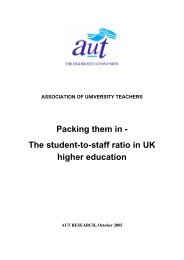
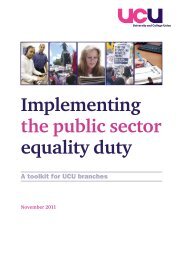
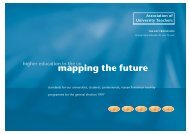
![(.pdf) [29kb] - UCU](https://img.yumpu.com/50914942/1/184x260/pdf-29kb-ucu.jpg?quality=85)
